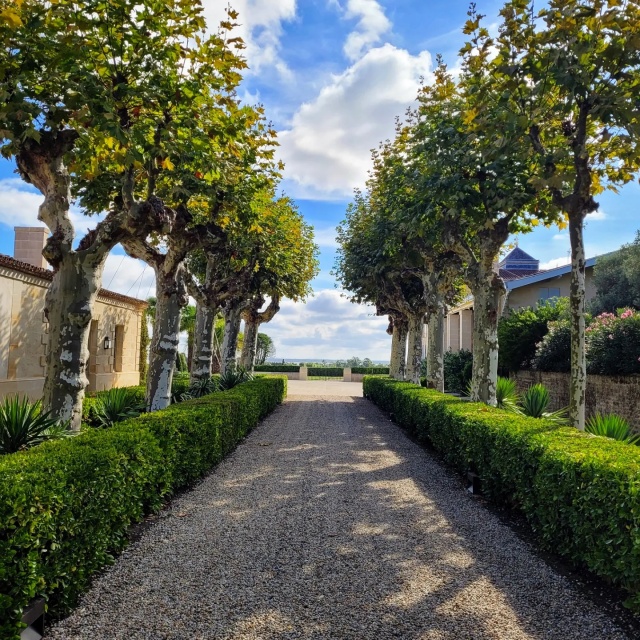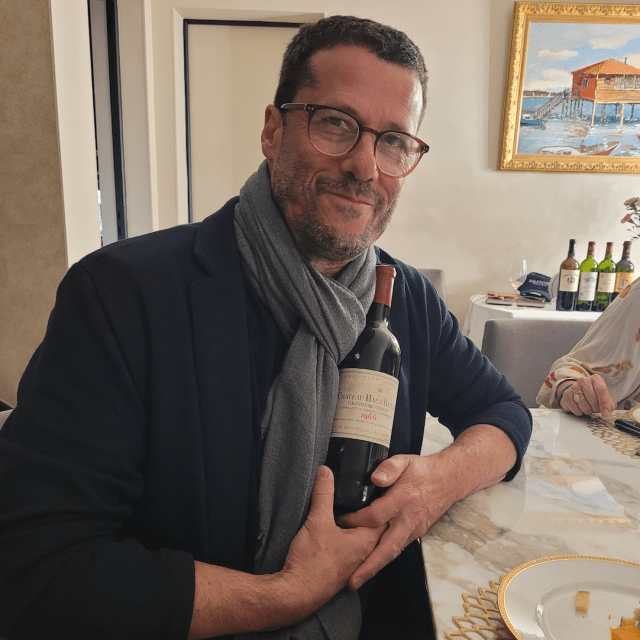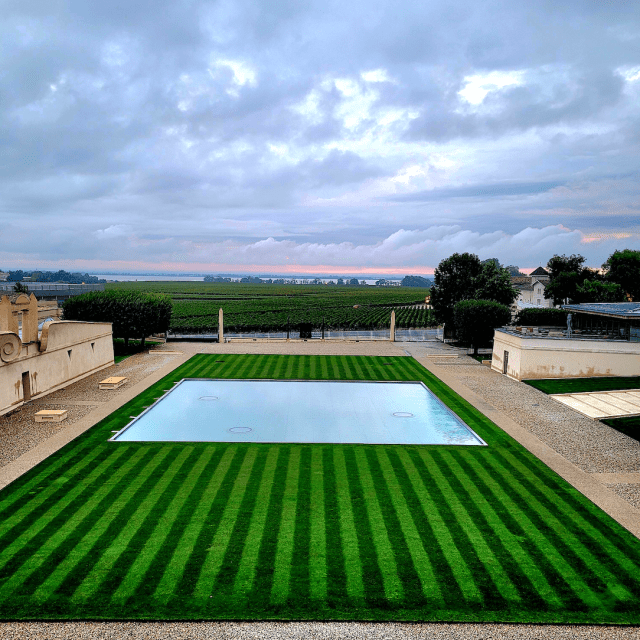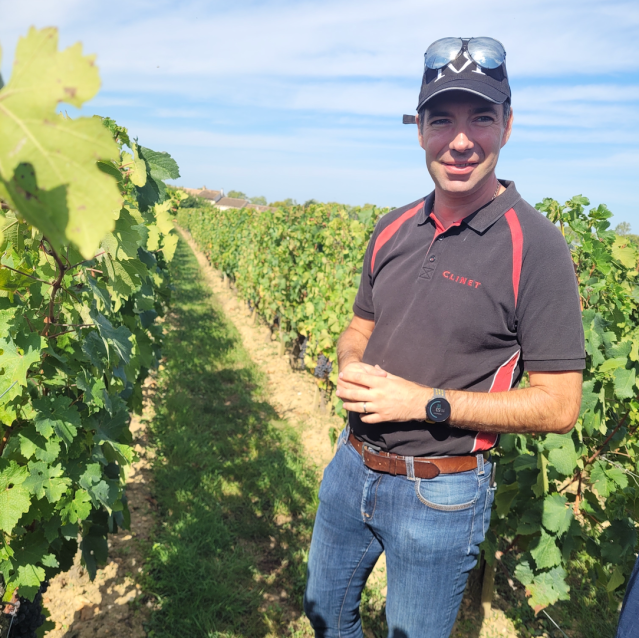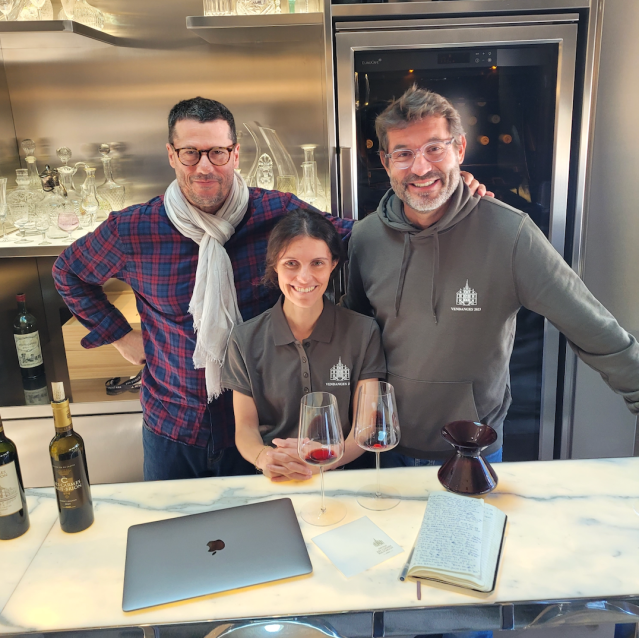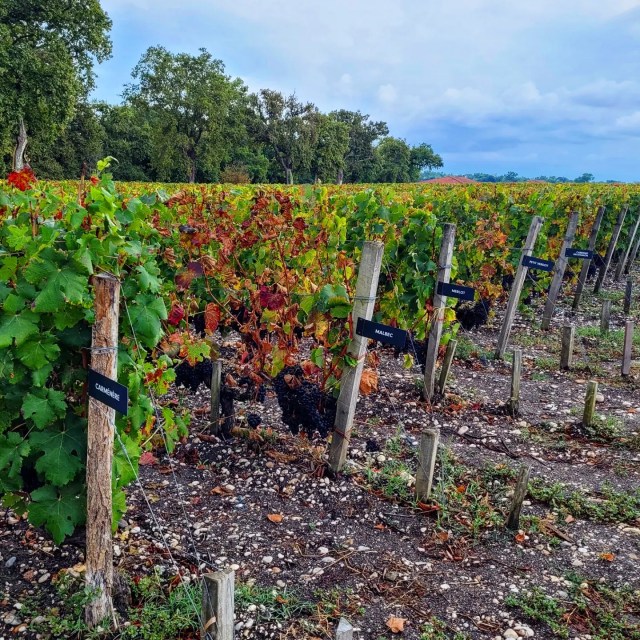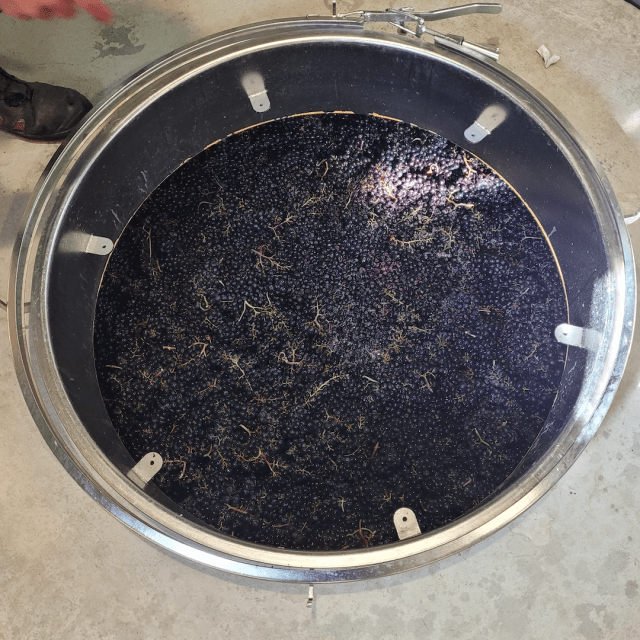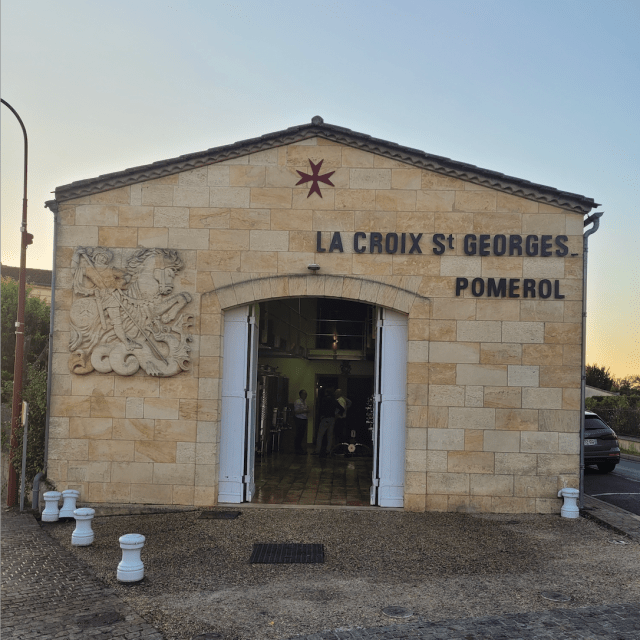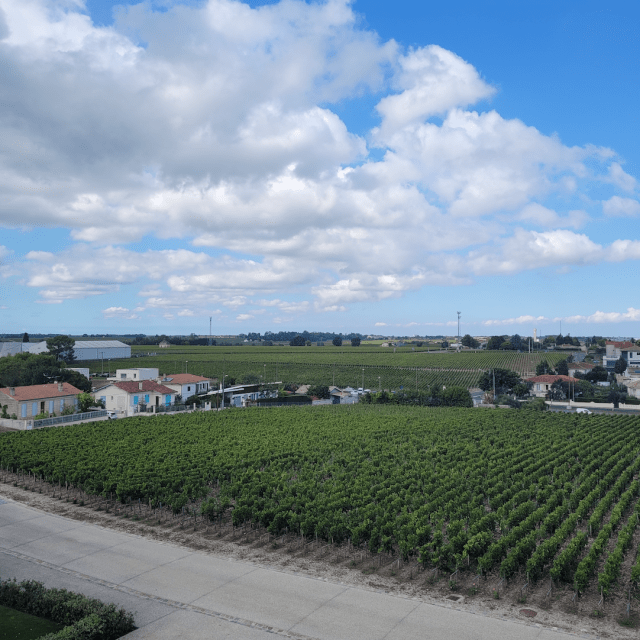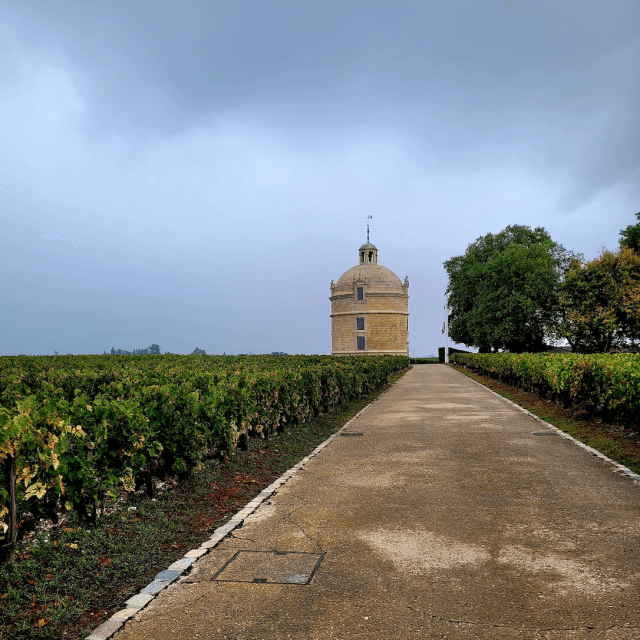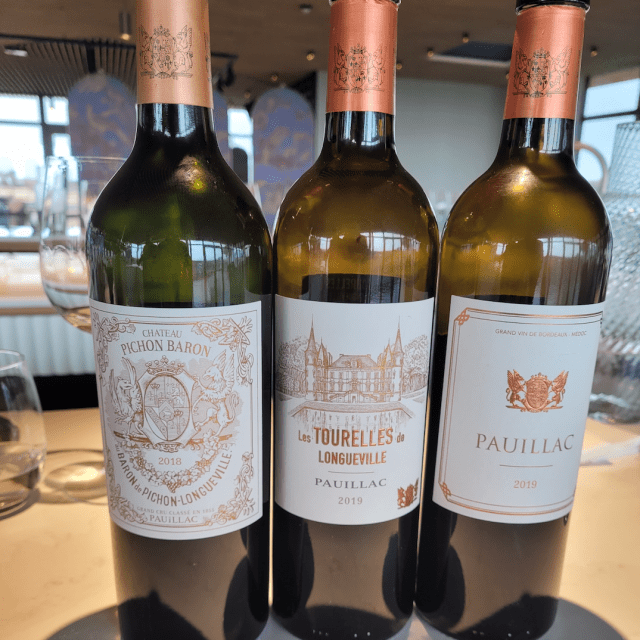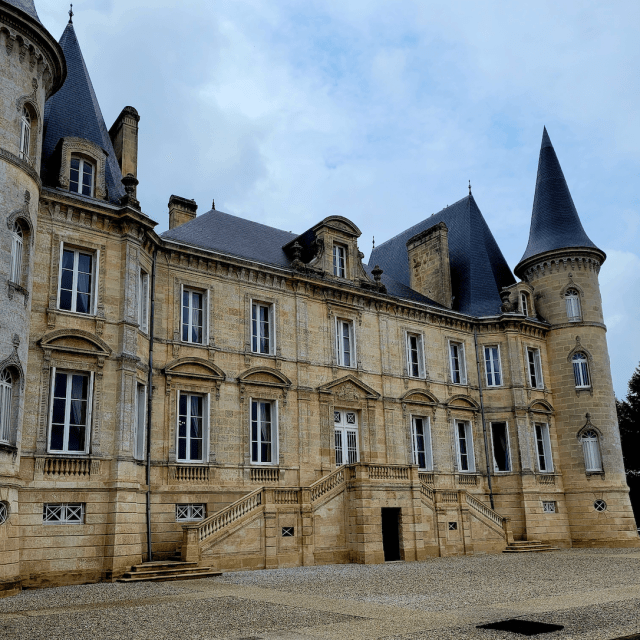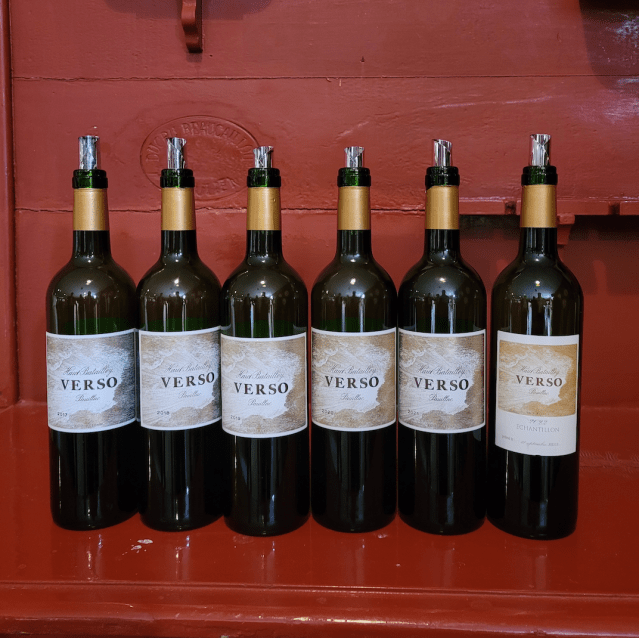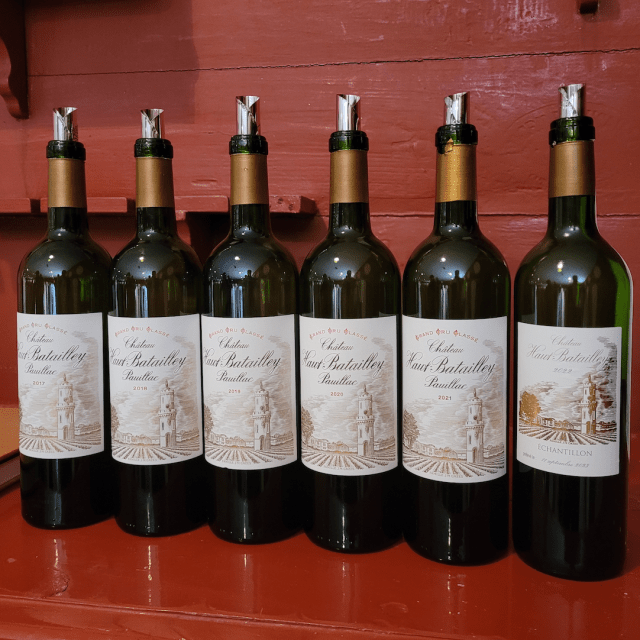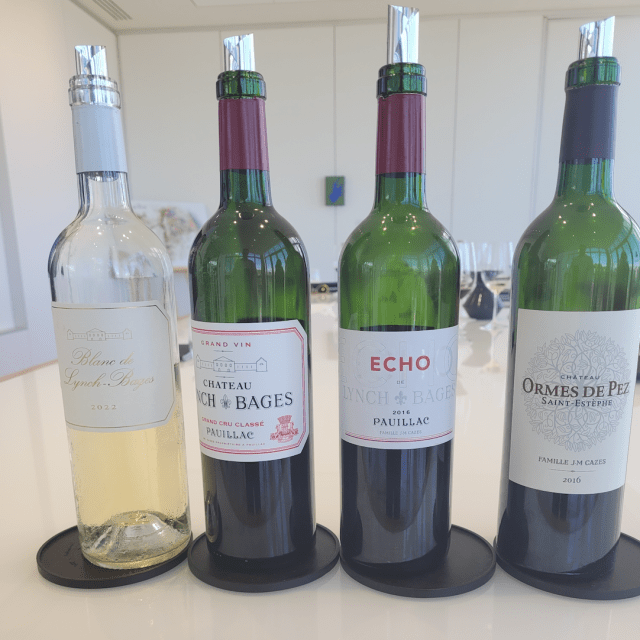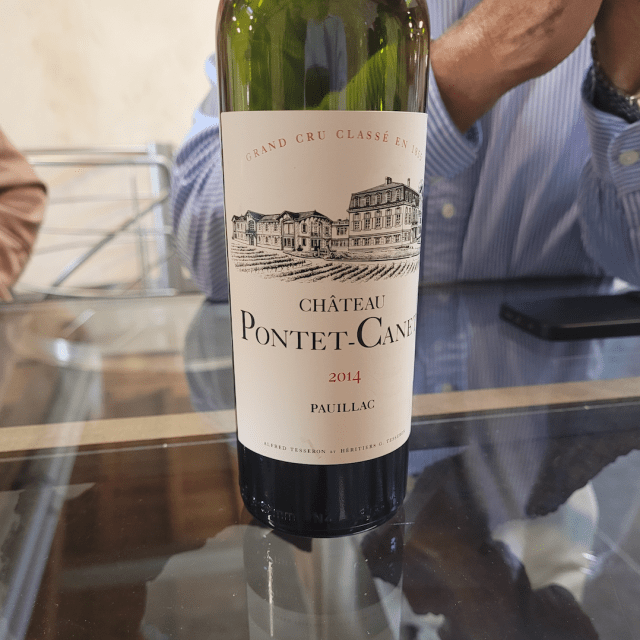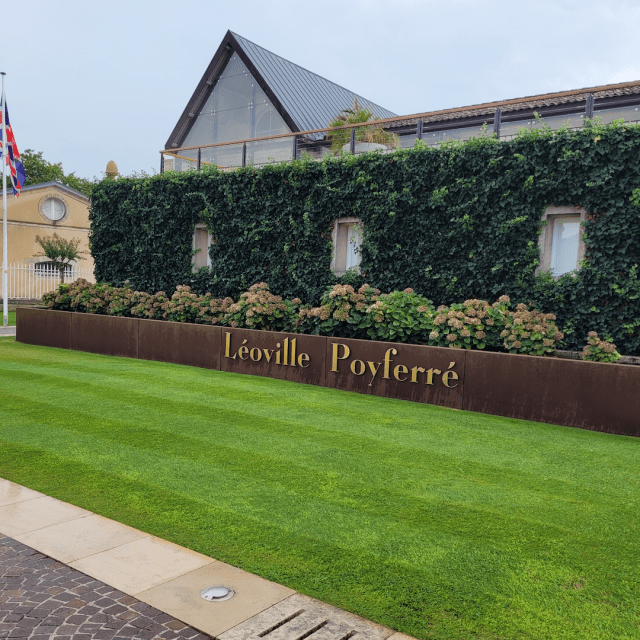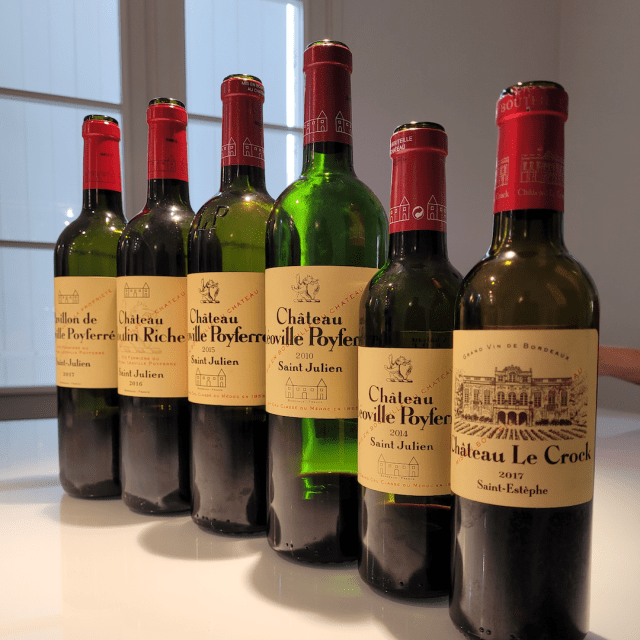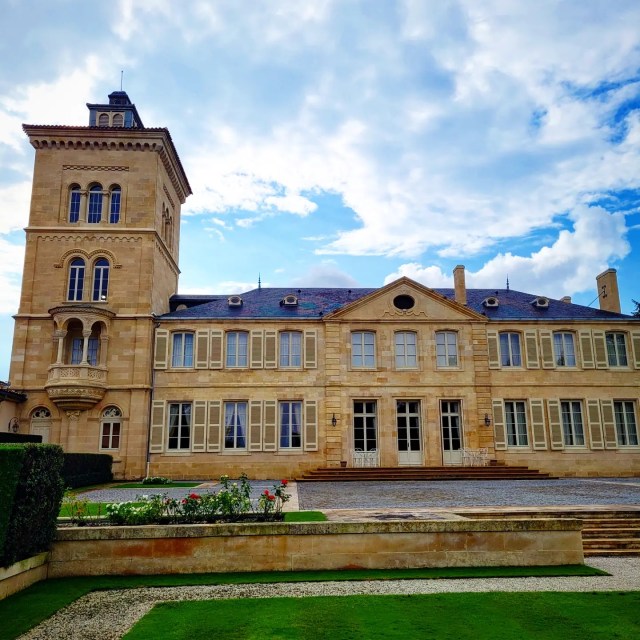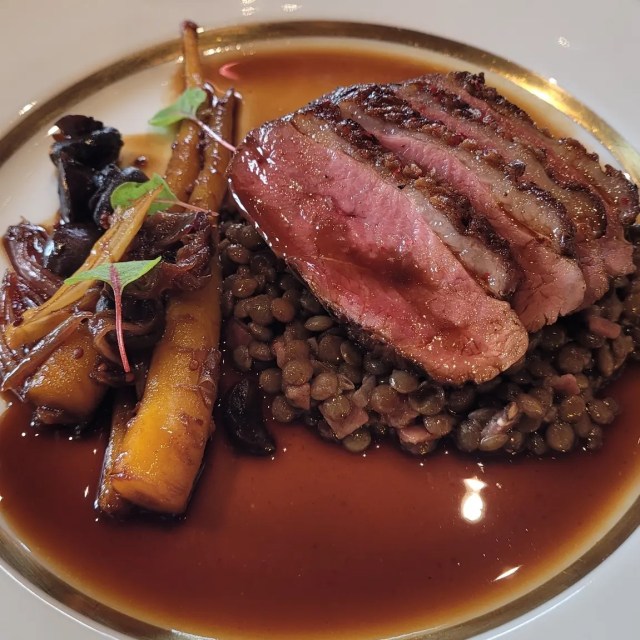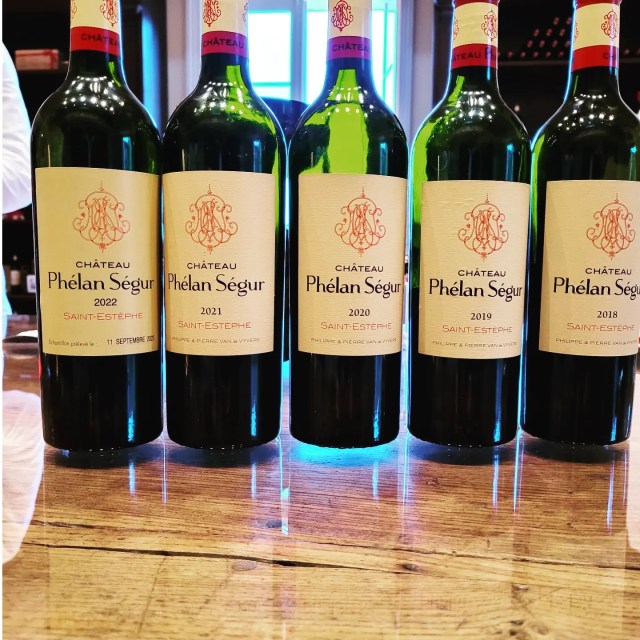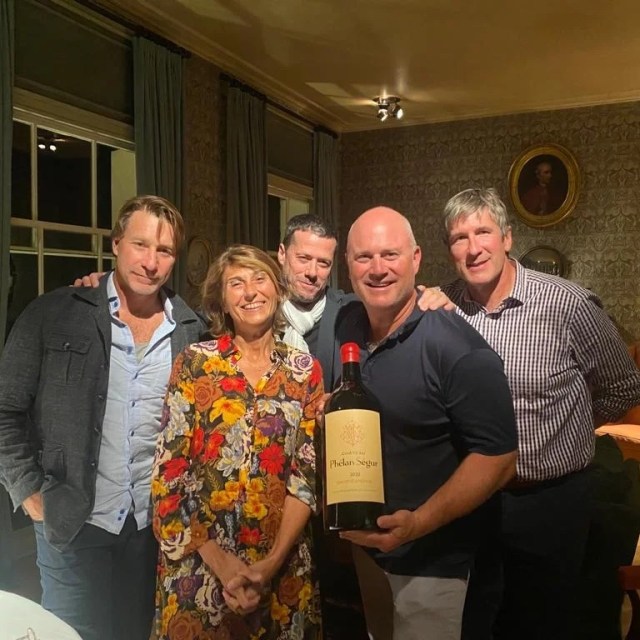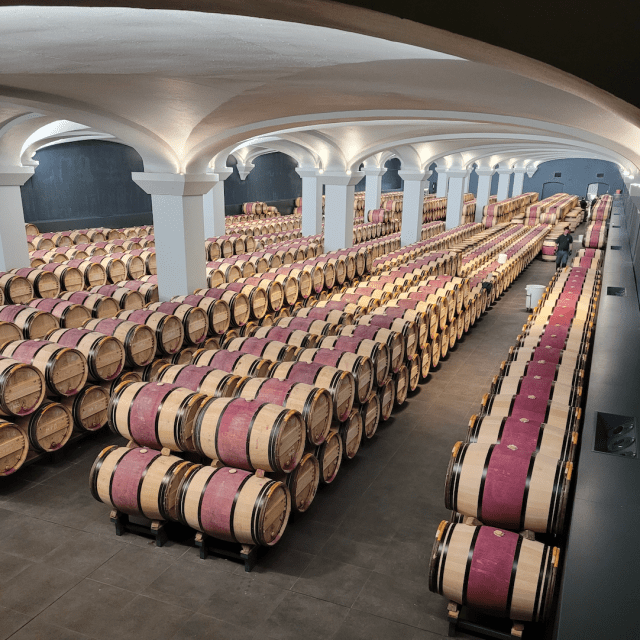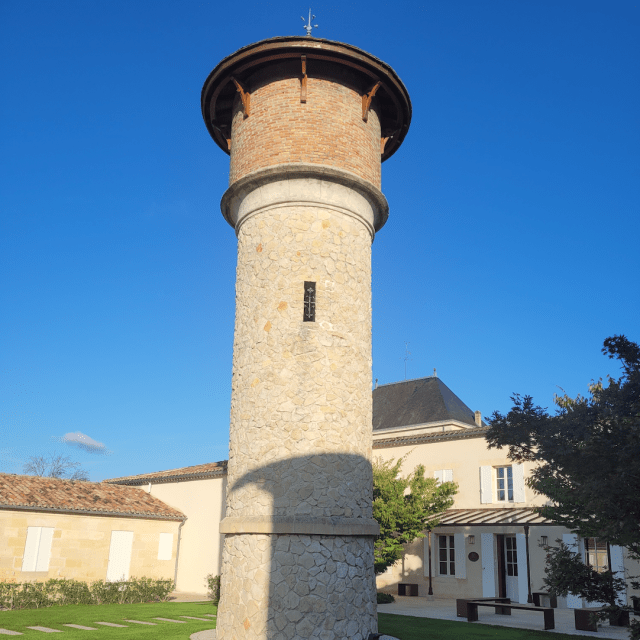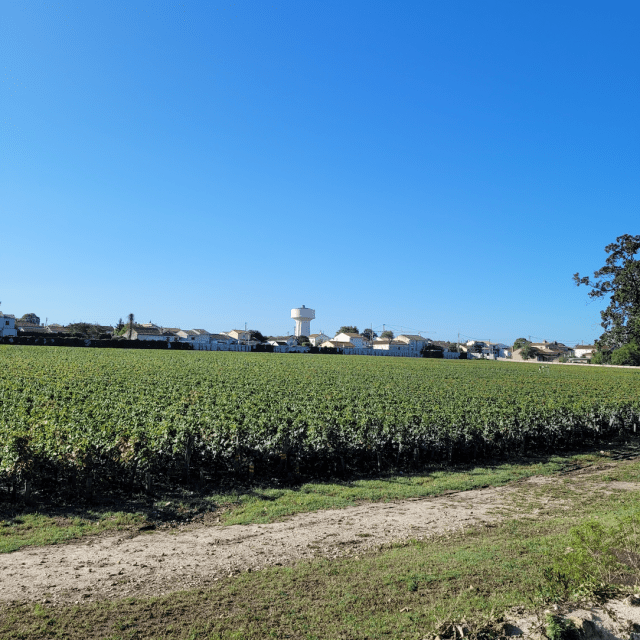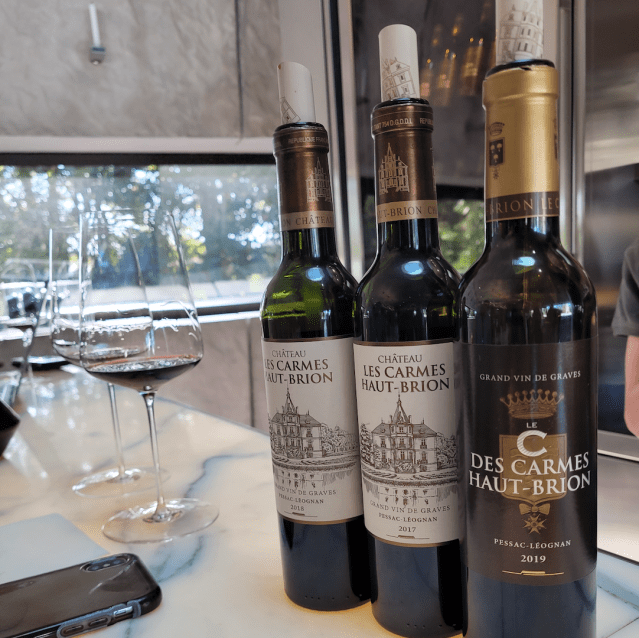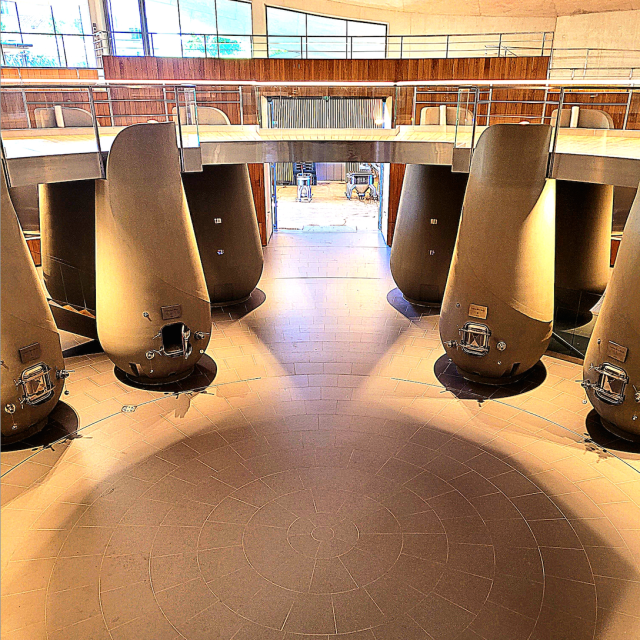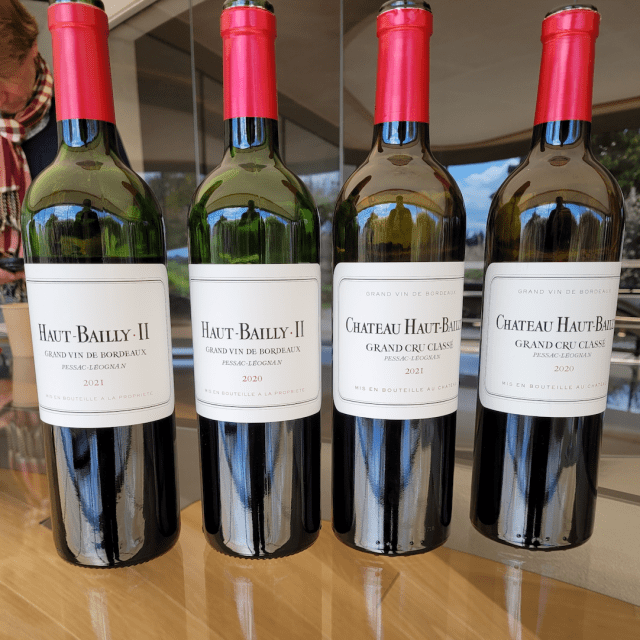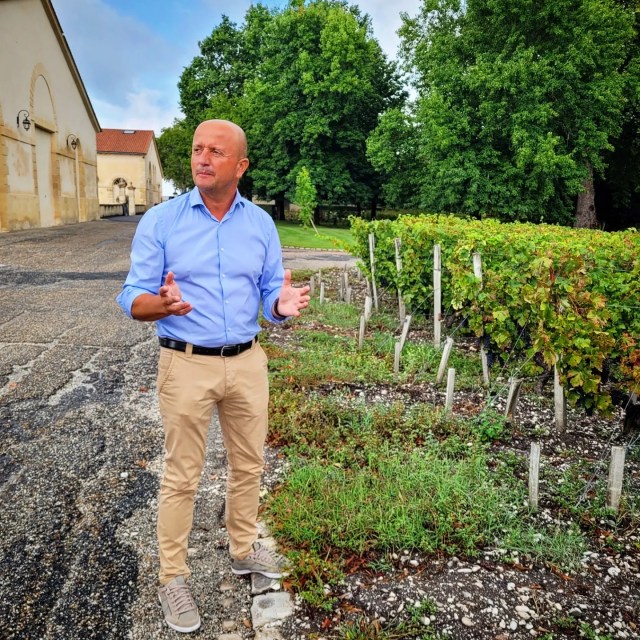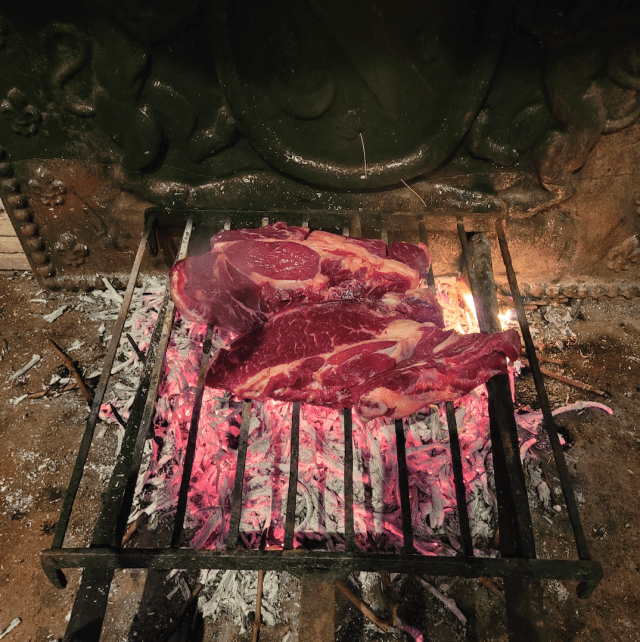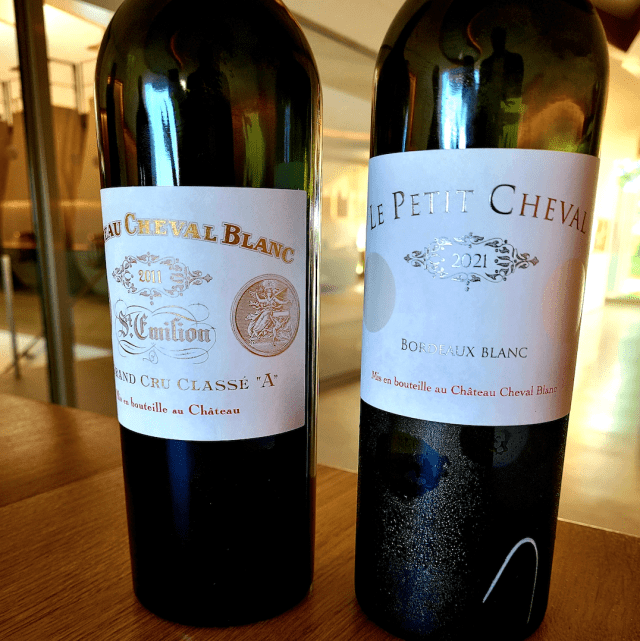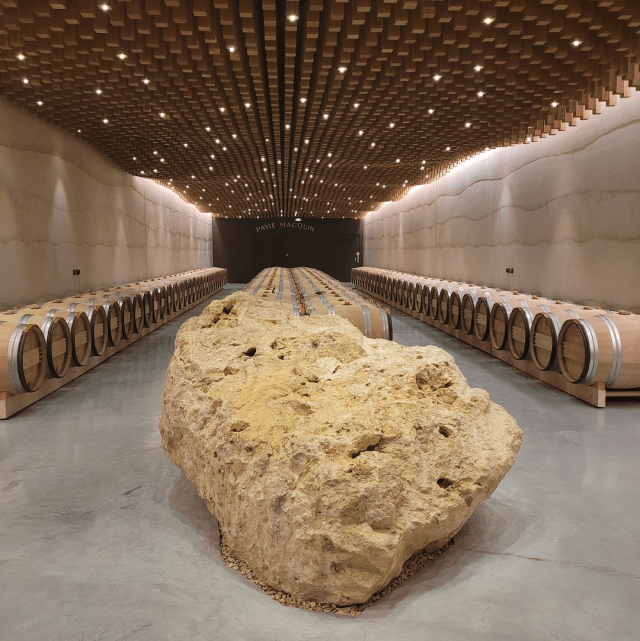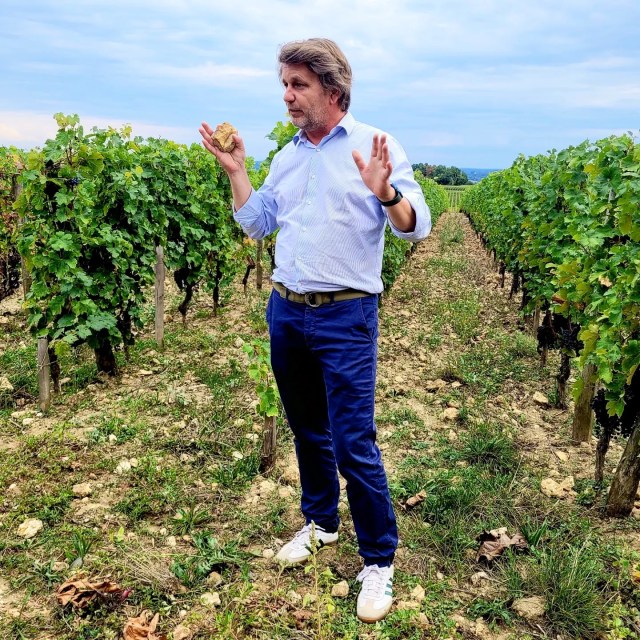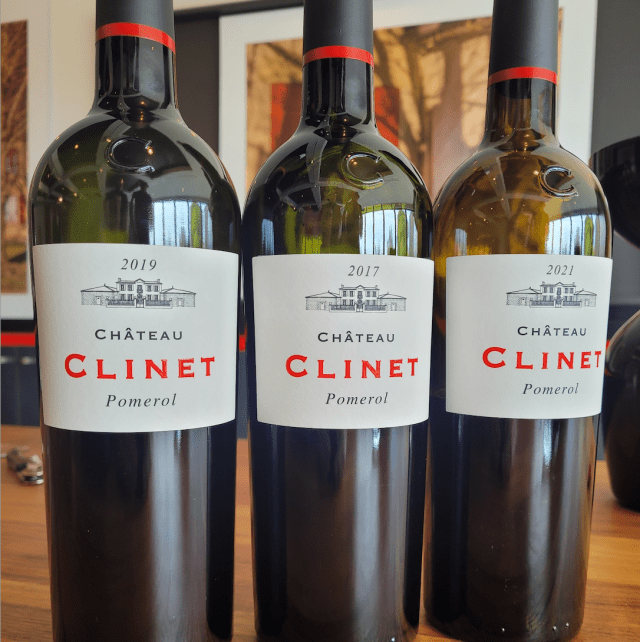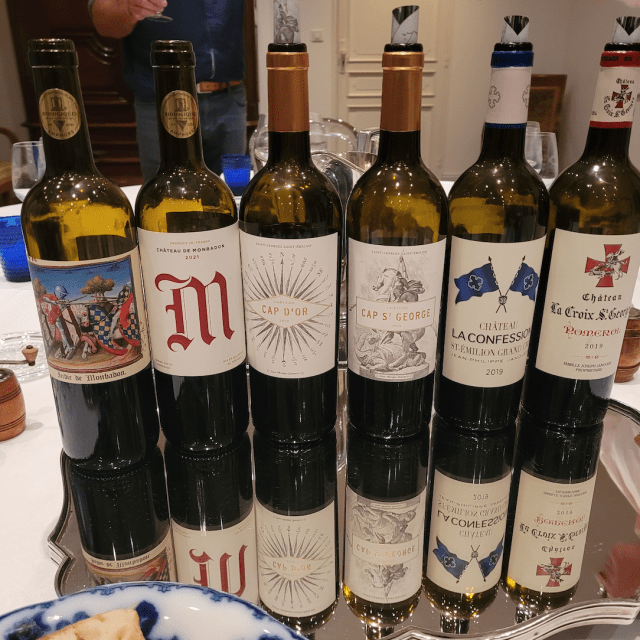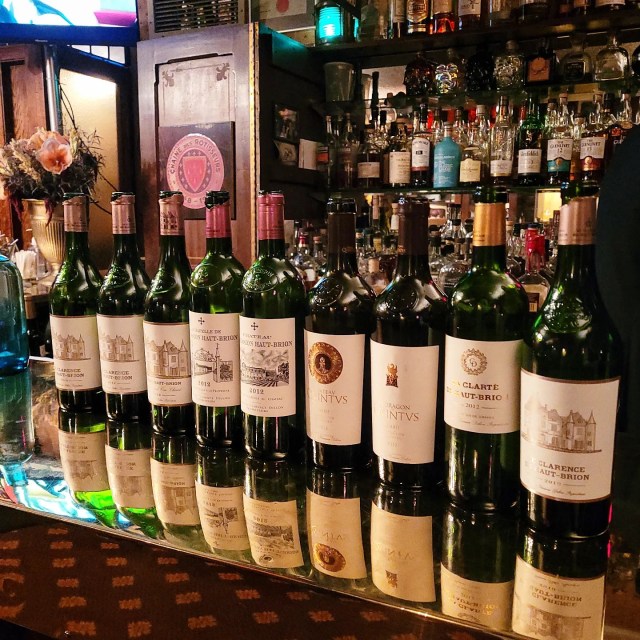As you will see over the coming 20,000 words in this report, the trip summarized is not your average, every other week excursion to another wine region in Europe. No, this lengthy article will in fact describe a personal opus, an epic, once in a lifetime journey to Bordeaux. A five-day fantasy traipsing through the clay and gravels on both banks of the Gironde Estuary to come away fed, nurtured, nourished and experienced in the history, breadth and depth of the place. May as well just list the properties straight away because the itinerary is what need be considered legendary. In Pauillac – Château Mouton Rothschild, Château Latour, Château Pichon Baron, Château Haut-Batailley, Château Lynch Bages and Château Pontet-Canet. Saint-Julien – Château Léoville Poyferré and Château Lagrange. Saint-Estèphe – Château Cos d’Estournel, Château Phélan Ségur and Château Montrose. Margaux – Château Margaux and Château Brane-Cantenac. Pessac Léognan – Château Les Carmes Haut-Brion and Château Haut-Bailly. Saint-Émilion – Château Bellefont-Belcier (Vignobles K), Château Cheval Blanc, Château Pavie-MacQuin, Château La Confession and Château Troplong Mondot. Pomerol – Château Clinet and Château La Croix St. Georges. Visits, meals and great wines shared with two prominent négo0ciants – Nathaniel Johnston & Fils and Compagnie Médocaine des Grands Crus. A sum total of 22 properties with more than 50 estates’ wines poured and tasted.
Selective histories and size matters
We begin with the large, rich and famous. With the 1924 vintage, a then 21 year-old Baron Phillip de Rothschild launched the program of having each bottle of Château Mouton Rothschild’s label designed by a different (and very famous) artist. The estate is comprised of 700 hectares in Pauillac, also in ownership of 40 with Château Clerc-Milon. At Mouton 80 percent is cabernet sauvignon, with (16) merlot and (4) cabernet franc. Mouton Cadet was created in the 1940s. Château Phélan Ségur was originally owned by and Irishman and purchased in 2018 by a wealthy Belgian who made his fortune in containers (Europe and Africa). There are 114 hectares total, 40 of vines split up into four plots, two up to the furthest northern edge of Saint-Estèphe and two further south nearer to the Gironde estuary. Incidentally no relation to Calon-Ségur. The newest ownership at Château Montrose dates to 2006, by Martin and Olivier Bouygues who came from Telecomm and poured significant investment into the property.
Château Batailley is at the southern border of Pauillac, across the road from Lynch-Bages, abutting Saint-Julien and it is the tower that marks the entry into the appellation. It was acquired by the Cazes family in 2017 with Jean-Charles now at the head. The name Batailley comes from the fight during the 100 years war between the French and the English. The chateau was separated in 1942 and the western part became Batailley, nearly 100 years after the 1855 classification. Was owned by the Bourie family and is now the only classified (5th) growth that became one before being split in two. Speaking of classifications, no discussion considers a paradox as great as that of Château Haut-Brion and Château Les Carmes Haut-Brion. One is classified while the other is not and yet the latter sits on a property occupied by the former but is arguably one of the finest terroirs in the entirety of Bordeaux. One only has to taste the last five vintages of that Grand Vin to wonder how it can possibly not be qualified as a classified growth. The modern turning point for it’s current status and affairs can be traced back to 2010 when its was purchased by Patrick Pitcher. Another Péssacc-Léognan estate is Château Haut-Bailly with vines dating back to the 1400s and today’s über modern facility was built by the Wilmer family, bankers from Buffalo (New York) who purchased the estate 20 years ago. The property is home to some of the first vines planted after Phylloxera, some now as old as 120 years.
Bordeaux’s total plantings are approximately 100,000 hectares and in Saint-Émilion the average vineyard holding is between five and six. That makes Vignoble K’s Château Bellefont-Belcier seem large at 23. Still that size is just half of Château Quintus with their 45 hectares – that puts it in large company. In Saint-Émilion the land decides the classification, not the estate which is the rule in the Médoc and across appellations on the Left Bank. If you add land in Saint-Émilion you have to make a different label and vinify in a separate cellar. Vietnamese-born Peter Kwok has started at Château Haut-Brisson, moved through Pomerol and Castillon and now owns Château Bellefont-Belcier along with Château Tour-Christopher. Each of the estates are a small unit, independent and self-functioning.
It was December 15, 1998 when the Château Cheval-Blanc estate was sold to LVMH Chairman and Belgian Businessman Bernard Jean Étienne Arnault. He is the founder, chairman and CEO of LVMH Moët Hennessy Louis Vuitton, the world’s largest luxury goods company. The land has likely been producing wine since before the 100 Years War, possibly as early as the 1400s. It had been purchased and designated as a chateau in 1832, which in terms of historical Bordeaux is relatively late. The owner was ahead of his time having designed drainage systems from the 1830s to the 1850s to deal with the heavy clays. The name Château Pavie Macquin comes from a combination of the place and the legend Albert Macquin, an agricultural engineer who popularized grafted plants which would save the vineyard after it was ravaged by phylloxera. Pavie Macquin was classified as the first Grand Cru Classé Saint-Émilion. “If you underscored the classification,” says current generation proprietor Cyrille Thienpont. “then the explanation was bad.” The last classification brought together Pavie Macquin and Pavie Macquin-Decesse, not just Pavie Macquin and Pavie. Château Troplong-Mondot is owned by an insurance company called SCOR.
From the 11th until just a century ago the L’Eglise de Pomerol was located right at the site where Union des Grands Cru de Bordeaux President Ronan Laborde’s Château Clinet sits today. Pomerol’s size is 815 hectares shared between 120 producers and bottlers though some do sell in bulk to Bordeaux wine merchants. You can’t age or bottle wines outside of Pomerol and agents must also buy finished wines to label it as such. The word Clinet comes from the name of a seeded fruit that existed in the time of Christ, as did vines in the area. Most production is much smaller as compared to Saint-Émilion and the Médoc, the exception being Pétrus at 35,000-40,000 bottles and prices are highest in the appellation. The two complimentary varieties of merlot and cabernet franc dominate though Clinet farms 25 percent of their vines to cabernet sauvignon. Vines planted in 1950 that survived the (-20 degrees celsius) 1956 February freeze are still in production, in top shape, give small berries and are rarely susceptible to mildew. Laborde notes a true salty-mineral quality in Clinet’s cabernet sauvignon.
Heterogenous terroirs, varietal adjustments and climate events
Using the name Bordeaux and the word elevation in the same sentence may seem like an oxymoron but all things being relative the search for subtleties begins with the unseen changes in landscapes. A “butte” is as small a mountain as you might find and yet still proffer up an indication of elevation. “Cos” is a small hill from Old French, though no Google search (without a qualifier) will tell you that. The name Cos (with the S pronounced) refers to a “hill of pebbles” in Gascon dialect and the name Cos d’Estournel was given in 1810 by Louis-Gaspard d’Estournel. At Château Les Carmes Haut-Brion seven of the 15 “city” hectares are defined as a “Cos.” In the 16th century this was the site of Château Haut-Brion. At the time the owner gifted the property to the order of the Carmelites Blanches. There may or may not have already been a “Cos” then. In Pauillac soils are arid, of sand and gravels and just a small amount of limestone and clay at the 26m high “mountain of Pauillac.”
Château Pichon Baron’s Pauillac terroir includes clay and also chalk beneath which makes for two-way conversions of both water retention and drainage. Château Phélan Ségur’s northern blocks are truly gravelly overtop heavy clay subsoils, more clay than those closer to the Gironde. The clays are really helping with the challenge of extreme heat days (18 of them over 40 in the summer of 2023) by maintaining water and freshness. At Château Tronquoy the soils are really gravelly with larger stones like Châteauneuf-du-Pâpe, a truly unique terroir for Saint-Estèphe. More clay composition at the surface in the Tronqouy soils as opposed to sister property Montrose (and also Dame de Montrose) where that clay lays lower, below the sand and gravels. Château Les Carmes Haut-Brion’s city vines do not cool down like the 35 hectares found in the countryside though they are are still within the limits of Pessac-Léognan. The Bordeaux city vineyards are generally three degrees warmer, especially at night and the Grand Vin is produced from these vines. The blue clay here is special, much less “sticky” than Pauillac and integral to the ripening and development of the cabernet franc. Horses are used in the vineyards to reduce the amount of tilling, tractor and machinery disruption.
Château Montrose is 85 hectares planted closest to the estuary of vines that in terms of vigour are truly self-regulating. No bunch thinning is necessary, especially for highly concentrated cabernet sauvignon. This part of Saint-Estèphe on average runs a week to 10 days behind for harvest times. There are 40 hectares, 21 under vine, 19 still to be planted, 65/35 cabernet sauvignon and merlot. Studies in dug hole pits has convinced the team to add a small portion of petit verdot, to make up two percent of the overall mix. Redevelopment has been ongoing seen 2017 though the Bourie has already reconstructed the winery. Château Haut-Batailley in Pauillac started covering between rows with cover crop between in 2020.
In the area of the Saint-Émilion chateaus occupied by Quintus, Pavie and Ausone the soils are mainly clay-loam with limestone near or on top of the surface. At Château Bellefont-Belcier terraces have been constructed because of the higher limestone content. The vineyards of Château Cheval Blanc are a result of how the tertiary period left behind a salty limestone plateau which extends from Cognac through the Right Blank along the Gironde Estuary to central France. The retreating river left behind gravels that were dragged over each other and so Cheval Blanc is a heterogenous terroir that is a mix of sand, clays and gravels. CFO and commercial director Arnaud de Laforcade talks about “the big principle” when he says “we accept and celebrate the variability between plots to create the character of Cheval Blanc.” The cabernet franc and malbec planted at Cheval Blanc was a Right and Left Bank mix but that changed after Phylloxera with the switch to merlot. Much of Pomerol, including the soils of Château Clinet are clay with gravels layered on top. It is well known that merlot is the child of cabernet franc but only recently another genetic parent was (re)discovered through a variety called Magdeleine Noire des Charentes, named after the birds that arrived first to eat mature Bordeaux grapes.
Arnaud de Laforcade pontificates about cultivational philosophy. “We need to rely on ourselves and so all propagating and massal selection is done on the estate – kept to the estate.” A block of 1930 merlot is still in production and in fact any block that makes it into the Grand Vin can’t be uprooted. Of great importance is soil health. “Even if vines are based on poor soils, they shouldn’t be dead soils.” Cover crops are key, to maintain harmony, despite the competition. Clover’s penetrating roots are good for aeration and reduce the need for tilling. White radish for the bees, re-seeded every Spring. Only a shallow till is done in the Fall but not under the vines for fear of increasing humidity and inciting mildew. Trees are planted on rootstocks and pruned in line with the vines. All these tools are current ones and could very well updated in 30 years, possibly less. Bottom line is monoculture is no longer acceptable. Organics and biodynamics are encouraged but the reality is that no solutions are 100 percent perfect. “People who say they will be mildew free because of all these methods are dreamers,” is de Laforcade’s conclusion.
Different soils and sub-soils within the 45 hectares at Quintus lead to an agricultural approach that is almost “Bourguignons,” meaning a rank and file of estate, village and cru. Same applies to Château Pavie and Château Ausone. No wonder the hills and areas occupied by these estates are sometimes (quietly) referred to as the “Burgundy of Saint-Émilion.” Château Pavie Macquin’s terraced vineyards planted to 80 percent merlot and (20) cabernet franc are marked by a three-toned mix of clays; white at the top, mixed in the middle and brown down below. Pavie Macquin faces the village of Saint-Émilion with 15 hectares at the border which means the clays are laid overtop limestone. At the top the clay measures 14 cm and at the bottom the clay layers with limestone and “tender” limestone. A breezy place which means less mildew and disease pressure but also later harvests compared to the plateau of Saint-Émilion.
Chief Executive Officer of Château Troplong-Mondot Aymeric de Gironde introduces the non-eroded soil. “The real specificity is in the clay,” he explains. “It has been measured in square meters per gram.” An original clay, created at the same time as the rocks. The plateau is neo-clay, created by the disintegration of the limestone. Troplong-Mondot is original clay, not sin, a perfect pocket like Pétrus and so much more dense than that of their immediate neighbours. Its so dense it’s hard as rock. “At Troplong-Mondot natural density comes for free,” laughs de Gironde but he’s dead serious. “Here we don’t have to do much at all, if anything we have to be careful not to extract too much power.” The soils remind of Macigno del Chianti or better yet Formazione di Silano so prevalent in creating structured Chianti Classico sangiovese. “We’re now the first to harvest in the area,” says Aymeric. “We cultivate the differences of parcels and build the wines by blending.” The mix is 85 percent merlot, (13) cabernet sauvignon and (2) petit verdot. He has been with TM for six years. “Tasting 1998 and 2004 were great indicators to me for what to do in the vineyard.” On the property of Château Phélan Ségur a weather warning system is in place and the estate heads up a Saint-Estèphe program to release weather balloons in the face of hail storms. Hard not to be reminded of Angelo Gaja who more than 20 years ago was sending helicopters equipped with weather altering technology into the skies above Barbaresco. In the Médoc hailstorms are increasingly problematic and when they strike they can be devastating to a season’s crops.
Changing fermentations, elévage and varietal designs
Château Mouton Rothschild’s approach is unique because alcoholic and malolactic fermentation are completed simultaneously over three weeks. Aging is one year in barriques, followed by 50 percent new beyond. There were 92 different block vinifications during the 2022 harvest at Château Montrose. Malolactic begins directly after the alcoholic fermentation – they are contiguous, not simultaneous. At Château Les Carmes Haut Brion the new chapter is written through winemaker Guillaume Pouthier’s infusion methods whereby whole berries and whole bunches are layered mille-feuille style for a new kind of submerged cap way of keeping juice at the top and the most gentle way of breaking down skins without any crush. At Château Cheval Blanc the prefernce is to do all fermentations in concrete vats, remove the skins at the initial alcoholic fermentation and not to handle things simultaneously. The cellar master’s job is to make everything “fine,” not more.
Château Phélan Ségur’s yeast program pays homage to its bacterial history – isolated yeasts strains are propagated from l’Enclos, the heart of the vineyard and historical Phélan plot, then used to ferment only that plot, in that vintage. “The initial results were exceptional , tells Managing Director Veronique Dausse, “and so in the subsequent vintage it was done with other plots in the north.” After three years of comparing to commercial yeasts the realization was had that vintage does not effect outcomes and that indigenous yeasts create more consistent typicity, so long as a cocktail of yeasts are employed from plot to plot, as well as no cross contamination between fermentations. Some merlot in the south have been added this year to be part of the experimentation.
At Château Margaux less and less merlot is being used and so new plantings are mostly cabernet sauvignon but increasingly also cabernet franc. Not yet certified but fully organic practices have been followed since 2019. Depending on the vintage Château Les Carmes Haut-Brion’s new oak usage is 70-80 percent. Château Bellefont-Belcier’s technical director Emmanuelle Fulchi d’Aligny insists on cellar conditions that are clean, clean, clean and low, low, low fermentation temperatures. The wine was classified in 2006, ferments are partially pressed, free-run juice is key, concrete tanks stabilize the wines and they use just 30 percent new oak. Troplong-Mondot’s Aymeric de Gironde uses cold macerations and one-third pumpovers through the course of a day.
Please don’t call them “Second Wines”
“Calling them second wines is a mistake,” insists Château Haut-Brion’s Guillaume Alexandre Marx, “and it always has been.” All one has to do is consider the farming. “It’s the same as it is for the Grand Vin. Several “other” wines were tasted at chateaus along both the Left and Right Banks and while terms like second and third were conjured, the nomenclature has long since drifted away from these kinds of notions. Today they encompass labels like Château Lacoste Borie, Duluc De Branaire Ducru, Le Dragon De Quintus, Les Forts de Latour, Les Tourelles de Longueville, Les Griffons de Pichon Baron, Pauillac, Verso, Echo de Lynch Bages Famille J M Cazes, Pavillon de Léoville Poyferré, Les Fiefs de Lagrange, Pagus De Lagrange, Les Fleurs du Lac, La Dame de Château Montrose, Margaux de Château Margaux, Pavillon Rouge de Château Margaux, Margaux de Brane Henri Lurton, Baron de Brane Henri Lurton, Le “C” des Carmes Haut-Brion, Haut Bailly II, “G” d’Estournel, “Lions de Sudiuraut,” Les Tours de Belcier, Mondot de Troplong Mondot, Le Petit and Indie de Monbadon. There are dozens more but these are but the examples tasted in the last year.
Older vintages and 150 tasting notes
The collective theme of the last 15 months seems to have focused on maturing, yet far from tiring Bordeaux vintages. Many pours have come from the 2014, 2012 and 2011 vintages. Less than heralded ones it has oft been noted though today the three are drinking beautifully. Hard not to be privy to the notion that the chateaus pouring these wines are in that requiem period of needing to sell some cases sooner rather than later, but the other truth is when wines are showing well they open more doors more than close them. Skeptics would say the opposite but truth is truth and the ’11s and ‘14s especially are in a special place. The terroir is truly there. How do we know? Freshness and transparency. Is that not exactly what to expect from a high quality wine of Bordeaux? At a Domaines Clarence Dillon tasting in Toronto last year Guillaume Alexandre Marx chose 2012 because “it is a vintage I love and it has now entered into it’s drinking window.” Coincidentally speaking the vintage is also one that equates quality with quantity, meaning they are sure to impress and there is still some product to be sold. Other vintages are either not ready, are much scarcer or just don’t meet the quality. Old Bordeaux are the sort to hover right there with rhythmic, syncopated and metronomic pace. Wines that maintain composure with aromatic perfume and the sweet development of acidity while tannins are essentially and fully resolved.
In September 2023 the vintages being poured were mainly 2019 and 2018, though a few 2021s and 2020s as well, while the overall range was greater than what is generally offered out of most regions worldwide. The 18’s are Bordeaux of a warm vintage (though ’19 and ’20 took it further) but there is just something about the wines on the 9’s, especially on the Left Bank. Lush, enveloping productions, in Pauillac so luxuriant they gloss over aesthetic differences between varieties and seamlessly ties them together. For Saint-Julien the wines are chewy, both the wood and also tannin are grand, though also sweet, enticing and overall quite amenable. As for Saint-Éstephe well the wood is big, grip is formidable and tannins remain mired in the gravel and clay, not nearly wanting to release the fruit for accessible play. But the concentration and precision are wholly impressive and the impression left is serious indeed. Not a complicated year but the wines are stiff, know how important this life is and what it will be. A top ranking vintage for Bordeaux as a rule but for Saint-Estèphe the glory is real. For Péssac-Léognan a crazy concentrated and also spicy vintage, of savour, county character, salt and pepper seasoning. Beautiful rusticity, fine chalky tannins and length down a long gravel road.
In Saint-Émilion there is this mouthful of fruit freshness, sharp and pointed acidity that culminates in major tannin adding up to seriously proper tension. The cabernet franc leads, fills, expands and creates what can only be described as an explosion upon the palate. When merlot hits right it transmits as contained and controlled power, especially from the generously wooded 2019s but my goodness the saline freshness, chalky quality and silken tannin wrap up the fruit with a ying-yang of nurture and grip. As for Pomerol, more variegation but every layer is deeper and richer than the last. If 2018, 2020 and 2021 build and build then 2019 is compact, not dense but composed of many films upon films and there is this pressed leathery fruit aspect indicated by the aromatic wealth. People will swoon and die for this kind of luxe Pomerol and the tannins are dutiful, carrying the weight and extending the life of 2019 for what will be many years to come. All this to say stock up on 2019. The following are 150 reviews for wines tasted in Bordeaux back in September 2023, along with three previous 2022 visits from producers and négociants in Toronto.
Pauillac
Château d’Armailhac 2017, AC Pauillac
A blend of 67 cabernet sauvignon with (22) merlot, (7) cabernet franc and (4) petit verdot. Warm vintage and dry for the most part but June saw some rain so Bordeaux fared quite well as compared to many parts of Europe. Early flowering and equally early harvest meant concentrated and quick to ripen grapes. You can feel some desiccation but freshness still finds a way to persist. As per 2017 the acids are sharp, pointed and intense. Not a dusty Pauillac per se but one that castes a long shadow with high tones. Ready to drink, requiring food that seeks acidity and good for a few years yet. Drink 2023-2027. Tasted September 2023
Château Clerc Milon 2016, AC Pauillac
Both winter and spring were wet but then the faucets turned off, all the way to harvest and through 2017. More than half the annual rainfall came in that spring and yet the vintage is looked at overall as being a dry one. The mix in 2016 is 55 percent cabernet sauvignon, (29) merlot, (13) cabernet franc, (2) petit verdot and (1) carmenère. The merlot grows on cooler ground near the Gironde and it falls into line between the dominant sauvignon and the cumulative support of the herbal, pyrazine, tannic and toasty group. No doubt this is about as rich, luxe and substantial as it gets for Clerc Milon. Berries and espresso coagulate and coexist in a vacuum of sweet acidity and also tannin. Still tight and dropping hints of grip, power and force, yet to dissolve or dissipate, not even in the slightest. Big and stylish. Is it a C-M for the ages? Quite possibly, allegedly and ostensibly. Drink 2025-2033. Tasted September 2023
Château Mouton Rothschild 2015, AC Pauillac
No doubt an excellent vintage, even or especially by Château Mouton Rothschild standards with the all important balance between heat units, water and elongation for even ripening and ultimately balance. The 2015 is cabernet sauvignon dominant at 82 percent with (16) merlot and (2) cabernet franc. Just a pup this full, concentrated and mighty Pauillac but also so elastic, pliable, supple and surely generous. The acids are in utter control, an encapsulation of a vintage that wants to give but knows better and so it plays hard to get and we exercise patience. This is the Bordeaux equivalence of the Italian croccante, as a crisp, almost crunchy and markedly stony red. The soil tells the true story and then there is this matter of power matched equally by restraint for harmony of Mouton style. Never precious, always elegant, classic and stylish, great beauty incarnate without trying to impress, not even for a moment. Will age ever so slowly over three decades and likely live for another three or more, above and
Château Latour 2018, AC Pauillac
No fruit from Latour’s L’Enclos are used for the second and this third wine, only the more recently acquired plots in other parts of Pauillac. In this vintage a higher amount (12 percent) of petit verdot joins the cabernet sauvignon and merlot, bringing more peppery spice to the very fruity, especially for the vintage blend. As fresh as has been tasted for 2018 and drinking really well straight away. That said the structure is more than adequate and five more years easy remain for this level and epoch of consumption. Thirty minutes of air brings out more and more fruit. Drink 2023-2029. Tasted September 2023
Château Latour Les Forts de Latour 2017, AC Pauillac
Certainly much more taut and also firmer than the ’18 Pauillac with both the warmth and also the acid capture of the 2017 vintage. A more savoury Latour as well with just splashes of petit verdot and cabernet franc as salt and pepper seasoning to the nearly two-thirds cabernet sauvignon with merlot. Minty Pauillac this Les Forts, cool and juicy but as mentioned, still really tight. Classy wine all around with a more linear construct that will seek three more years of development. Dusty cocoa and espresso at the finish. Drink 2024-2032. Tasted September 2023
Château Latour Grand Vin 2011, AC Pauillac
The Grand Vin in 2015 is almost exclusively cabernet sauvignon (at 97.1 percent) with (2.6) and merlot and a quick splash of petit verdot. It’s clearly a more varietal focused Grand Vin than most, celebrating L’Enclos of Latour at the eastern and southern end of Pauillac. Vines that share terroir with Leoville Las Cases and here it just feels like perfection is the goal. OCD and non-compromised focus to make the purist, most complete Pauillac that is possible. This may have been one of the lesser heralded vintages in Bordeaux but as Latour it remains locked in tight, far from letting go and sure of its constitution, but also ambition. There are no flaws in this wine, the suit is tailored, the hair perfectly coiffed and the etiquette on point. Drink 2026-2038. Tasted September 2023
Château Pichon Baron Pauillac 2019, AC Pauillac
Not considered a “third wine” for Château Pichon Baron but one composed by selected plots of Pauillac. Primarily merlot (80 percent) with 20 cabernet sauvignon. More than ample and substantial vintage for such a wine and in fact this is likely just about as rich and luxe as it gets for Pauillac. Chalky, liquid grainy and still churning through its inner workings for a CBP3 to drink just about as soon as you are wanting to enjoy one. Good acidity as well, semi-sweet and flirtatious. Drink 2023-2027. Tasted September 2023
Château Pichon Baron Les Tourelles de Longueville 2019, AC Pauillac
Deuxième Vin du Château. Majority of cabernet sauvignon at 63 percent, from the terroir west of the state near Château Batailley. The merlot component is 32 percent, followed by (4) cabernet franc and (2) petit verdot. Certainly more grip and intensity as compared to the Pauillac but no less fruit in fact more plushness and layering are involved. The tannins here are just a bit austere and currently demanding so give this another year or two before readying glasses, a tasting and dinner that involves this ’19 Tourelles. Drink 2025-2032. Tasted September 2023
Château Pichon Baron au Baron de Longueville Grand Vin 2018, AC Pauillac
A challenging vintage for many but this is a glorious 2018 from the word go, perfumed and Pauillac pretty as per what Château Pichon Baron just has to be. Since 2012 the wine is shortened as simply Château Pichon Baron to eliminate any confusion with the property that includes the Comtesse. From terroir that includes clay and also chalk beneath which makes for two-way conversions of both water retention and drainage. A crunchy Pauillac, like a mouthful of berries and gravel to indicate how far away this wine is from integrating and fully liquifying into its sure to arrive silky smooth mouthful and mouthfeel. Tannins are full and still in their infancy but the fruit is exceptional for the vintage. Drink 2026-2039. Tasted September 2023
Château Pichon Baron Les Griffons de Pichon Baron 2016, AC Pauillac
Griffons is sold through the Place de Bordeaux négociants with more cabernet sauvignon (the young vines not suitable for Pichon Baron) as opposed to Les Tourelles de Longueville which is a parcel selection, mainly of merlot. Dark fruit, richer than many second wines and a true mini Pichon with truer to life chalky structure. Grippy and intense, full throttle and as Bordeaux very much a serious wine that falls into a fine line designed and led by the Grand Vin from Pichon Baron. Very fine. Drink 2024-2030. Tasted September 2023
Château Pichon Baron au Baron de Longueville Grand Vin 2014, AC Pauillac
Must be be said that this ’14 is showing with remarkable freshness while also full concentration that now slides and glides over the palate. Aromatically on par, as luxe and smooth with blessedly immaculate acidity, all aligned to speak for a maligned vintage that is high time it were universally declared as exceptional. Longevity makes up a great part of the equation and while nine years is a sneeze for top end Bordeaux it should never be taken for granted. The preserved freshness, an absence of crispy or crunchy bites and instead just this ease up on the palate. Adds up to a wine of distinct and philanthropic expression. Drink 2023-2036. Tasted September 2023
Château Pichon Baron au Baron de Longueville Grand Vin 2009, AC Pauillac
A wine that the team says was always approachable from the very beginning. There is just something about the 9’s in Bordeaux and especially Pauillac. The Abbey Road of Bordeaux, expressive of persistent peak freshness at this 13-14 year mark and will continue to show a similar ilk plus remarkable longevity for that many years more. Lush, enveloping production, a Pauillac so luxuriant it glosses over aesthetic differences between the wine’s varieties and seamlessly ties them together. Nary a moment’s secondary character and from a consciously cerebral point of thought this makes little to no sense. Yet there are times when vintage, appellation, estate and the universe conspire in the most magical of ways. “He say one and one and one is three” and so 2009, Château Pichon Longueville Baron and Pauillac “come together, over me.” Drink 2023-2036. Tasted September 2023
Château Haut-Batailley Verso 2022, Pauillac
Most perfumed recent bottling in fact the aromatic concentration is the best of a string of vintages between 2017 and this 2022. Pine evergreen again but most floral as well. Palate concentration as well, richly textured, layered and substantial from start to finish. Great variegate red fruit and without a doubt one of the finest Verso from Haut-Batailley from the Cazes family since taking control of these vineyards in 2017. Drink 2025-2030. Tasted September 2023
Château Haut-Batailley Verso 2021, Pauillac
Only in this vintage we find cabernet sauvignon at 40 percent with more (60) merlot and it really shows in the doubling down verdancy of the wine. Pine forest and solvent, roasted and toasted elements, some weedy-vegetal aspects and even a bit of reduction. Tart, tight, intense and far from relenting, either by austerity or chains of tannic command. Wait two years to allow some wood integration and the promise of a fleshing by the fruity parts. Drink 2025-2029. Tasted September 2023
Château Haut-Batailley Verso 2020, Pauillac
The first vintage made by current technical director Julien Galland and a notable change in style from what came before. More up front fruit and roundness, not soft because how can it be and the toasty elements are in line with the three previous vintages. Warm vintage but no 2018 here, yet somewhat weedy in that there is always a level of verdancy in these Verso labels. Chewy, with liquorice and some partially dried, leathery fruit. Well made for sure. Drink 2024-2028. Tasted September 2023
Château Haut-Batailley Verso 2019, Pauillac
Clearly a next step up in understanding of what this fruit means at Haut-Batailley with great help from the generosity and ease of 2019. Increased richness, concentration and layers of structure create a new oeuvre for a Pauillac that now begins to mean serious business. The nose is exuberant in delivery of much warmth, umami and spice before morphing into major stage presence with respect to mouthfeel. Minty cool savour again and some toasted elements. A thread of barrel style really runs through these three wines between 2017 and 2019 but the last one also happens to brings the fruit. Drink 2024-2029. Tasted September 2023
Château Haut-Batailley Verso 2018, Pauillac
A per the vintage the results across Bordeaux and even within Pauillac are variable, here with a slight stemmy character that comes across in variegate reds and greens. Much richer and developed on the palate with wood well integrated, spices running amok and a fine chalkiness. Very different to the 2017, lower in acid and yet the smoky, roasted fruit and toasty elements are consistent. Quite complex for 2018 and still rising towards its crescendo. Drink 2024-2028. Tasted September 2023
Château Haut-Batailley Verso 2017, Pauillac
The first vintage under the auspices of the Cazes family after purchasing the property in March of 2017. Only cabernet sauvignon (60 percent) and merlot, palate soft but with those perfectly elevating ’17 acids and wood that still sits up front with the fruit. Righteous verdancy, savoury and cool, of mint and a moment’s note of eucalyptus. Smoky in this regard and into roasted nightshades from a Pauillac that holds no cabernet franc. Unique 2017 in all respects, with good energy and toasty red fruit. A curious case of beginner’s experience. Drink 2023-2026. Tasted September 2023
Château Haut Batailley Grand Vin 2022, AC Pauillac
Spends 16 months in (65 percent) new barrels from six different coopers. The richest of all the Batailley wines, bar none, incredibly tannic and indelibly stamped with these vines and this appellation like no other. So many unresolved issues here, tannins so implosive and insular coiled so tightly around the fruit. Rich and generous but you’d hardly know it when you feel the extenuating circumstances of major structure. Drink 2027-2035. Barrel sample tasted September 2023
Château Haut Batailley Grand Vin 2021, AC Pauillac
The aim is 65 percent cabernet sauvignon with merlot and when the 2019 petit verdot plantings come into play they will take up approximately four percent of the blend. The 2021 is a bit of a verdant one, with fruit variegate between reds and some greens, liquorice and plum, evergreen savour and leathery fruit. Chalky in 2021, some tannic austerity and time needed to resolve all the parts. Drink 2025-2030. Tasted September 2023
Château Haut Batailley Grand Vin 2020, AC Pauillac
The first vintage of the Grand Vin made by current technical director Julien Galland is a major step up from the Verso label with a fine perfume and a most impressive level of concentration on the palate. An almost chewy Pauillac, of liquorice and so many red fruit aromas but even more so flavours. Impressive showing and a really stoic, partially impenetrable, far from showy and yet truly generous Batailley. Drink 2025-2032. Tasted September 2023
Château Haut Batailley Grand Vin 2019, AC Pauillac
The best of recent vintages (perhaps until the ‘22s come along) because fruit generosity is at the peak and balance is far more obvious amongst all the parts. Perfumed in ways that neither 2017 nor 2018 were able to accomplish and no trail away or off as it pertains to the texture and stage presence of the palate. Smooth and silken, tightly grained, compact and in charge. Really well made and true to the holy trinity of vintage, terroir and appellation. Drink 2025-2033. Tasted September 2023
Château Haut Batailley Grand Vin 2018, AC Pauillac
Whereas the finest fruit from 2017 was surely allocated to the Grand Vin it seems like 2018 was more of a split. This because of the challenge of vintage, hot and bothered and so there is a close affinity with the younger Verso sibling. Thicker on the palate, rich with a wood-influenced mix of chocolate and café. Some stem-weedy character is consistent with the Verso and here also some heat on the finish. Drink 2024-2028. Tasted September 2023
Château Haut Batailley Grand Vin 2017, AC Pauillac
The first year of the Haut-Batailley Fifth Growth classified Pauillac under the guise of the newly owned Cazes family. The typical spice in both aroma and also on the palate that is both Batailley and also Pauillac. You can sense the vintage acids straight from the nose whereas the mouthfeel sparks in fits because of the reaction between terroir and season. Quite fine for 2017 and chalky, tart and tight as well. This will continue to age and drink well. Major step up from the Verso bottling. Drink 2024-2029. Tasted September 2023
Château Lynch Bages Echo de Lynch Bages Famille J M Cazes 2016, AC Pauillac
The second wine of Lynch Bages has been named thus since 2008 though it existed for three decades before that. Like Ormes de Pez this is a very good Left Bank vintage and so Pauillac is also a place of great potential. Still a very young wine though minty and cooler with sweet acids singing in their vocal range of increased verbosity and generosity. This E de LB will do nothing but please beginning this year and will stay the course for a few more. The real secondary notes will likely begin in 2025 or 2026. Drink 2023-2030. Tasted September 2023
Château Lynch Bages 2014, AC Pauillac
Here again comes the sleeper vintage, unassuming and under the radar, now coming into its own across the Left Bank. A Bordeaux that speaks in a local vernacular, liquid chalky and grainy, still churning through inner workings and coming together for pleasure and beauty. Yet another estate pouring 2014 and for good reason because perhaps any time ahead of now the vintage may not have shown as well as it is now. Skeptics would say the opposite but truth is truth and the ‘14s are in a special place. The terroir is truly here. How do we know? Freshness and transparency. Is that not exactly what to expect from a high quality wine of Pauillac? Drink 2023-2029. Tasted September 2023
Château Lynch Bages 2003, AC Pauillac
Memory recalls and speaks of a very warm Bordeaux vintage but appellation matters and for Lynch Bages the northerly Pauillac location fared very, very well. No tertiary as of yet, only the maturing mid-points of secondary life. Hovering right there with rhythmic, syncopated and metronomic pace. Maintains its composure with aromatic perfume and the sweet development of its acidity while the tannins are essentially and fully resolved. Ideal to drink now as a mature Pauillac and should stay in this zone for up to five more years. Drink 2023-2026. Tasted September 2023
Château Lynch Bages 1995, AC Pauillac
Mon dieu what a spicy nose on the Lynch Bages 1995! Limestone chalky mineral bites as well, with cinnamon, nutmeg, clove and still thriving acidity. Served as a pairing with salty (extra vielle) Mimolette and the old hard orange cheese works magic with the spice cupboard of the LB95. Yes the wine is also rich and chocolaty but the lack of tertiary qualities and persistence of freshness are what makes for the extraordinary match. Classic Bordeaux abilities and experience on full display with cool northerly Pauillac character. Drink 2023-2028. Tasted Sepetmber 2023
Château Pontet-Canet 2014, AC Pauillac
The second last vintage where a second wine was produced as that was eliminated after the 2015 vintage. Biodynamic since 2004, Demeter certified since 2010. This being the 5th vintage and here again the window for tasting 2014 from Pauillac because they are simply wines that needed time. As do all but the near nine year mark seems to be the sweet spot and this perhaps even a bit further ahead having been poured from a half bottle. Love the perfume and the acidity, both sweet and vibrant, up there at the height of appellative heights. No stringency but there is some power and the finish is a pure, contiguous continuation of a primed and balanced expression. Still just a wee bit of unresolved chalkiness at the finish so there is some work yet to be done. Drink 2023-2032. Tasted September 2023
Saint-Julien
Château Léoville Poyferré Pavillon de Léoville Poyferré 2017, AC Saint-Julien
Second wine of Château Léoville Poyferré that used to include fruit from the Moulin Riche vineyards but is now exclusively from Poyferré estate. The blend in 2017 begins with 58 percent cabernet sauvignon, followed by (27) merlot, (9) cabernet franc and (6) petit verdot. Two weeks of harvest began on September 20th and while this does not come crashing over the palate or clamp down with a wall of tannin it does instead fill and grip like one wishes it would. This after six years from harvest and with settled balance. A fine wine in a fine place wth sweet balsamic acidity and just that right amount of polish. Drink 2023-2027. Tasted September 2023
Château Moulin Riche 2016, AC Saint-Julien
A late or maybe better said classic harvest, from October 5th to 20th with nearly two-thirds cabernet sauvignon plus (26) merlot and (11) petit verdot. A vintage so very rich in wood, texture and spice. Carries a lot of wood and does so very well but the ambition mimics or rather falls into line with the Grand Vin of Château Léoville Poyferré. No cabernet franc and it shows, with an absence of pyrazine and roasted nightshade but instead more decadent chocolate ganache and fine, fine coffee. Finishes long and strong. Should very well last a good bunch more years. Fulsome and a Bordeaux on the edge of Saint Julien with focus and trenchant purpose. Drink 2023-2029.Tasted September 2023Château Léoville Poyferré 2015, AC Saint-Julien
Harvested in classic timely fashion, from the 24th of September through October 10th and the blend is eerily similar to the ’16 Moulin Riche. The difference being there is some cabernet franc (3 percent) with (6) petit verdot. This is indeed a St. Julien that saw, soaked up and made use of its barrels, in the most substantial and luxe way. Chewy appellative wine, spiced and more floral than expected. Acids are exceptional for 2015 and tannins are certainly no slouch. A big LP pressed to both sides, each running longer than 40 minutes. Drink 2025-2034.Tasted September 2023
Château Léoville Poyferré 2014, AC Saint-Julien
The blend is 60 percent cabernet sauvignon, (35) merlot, (3) cabernet franc and (2) petit verdot. The underrated and understated vintage strikes again though it feels like St. Julien matures a little bit quicker than Pauillac. There are some leathery and drying fruit secondary notes with the very beginnings umami of truffle and cèpe. In lovely condition and ready for consumption. Drink 2023-2028.Tasted September 2023
Château Léoville Poyferré 2010, AC Saint-Julien
Warm vintage and while it really shows it’s also quite floral, lifted and refined. ’Twas an 18 day harvest culminating on October 18th with the finished blend at 56 percent cabernet sauvignon, (34) merlot, (7) petit verdot and (3) cabernet franc. So much wood and hard to believe how little this has matured but also how much the structure needs to allow fora settle. A truly magnanimous and blanketing vintage, a flannel of warmth and nurture for a wine’s thick and unctuous texture. Return in 18 months to two years to see what’s what and where it’s at. Drink 2024-2034.Tasted September 2023
Château Lagrange Les Fiefs de Lagrange 2019, AC Saint-Julien
The second wine of Château Lagrange that came about because until 1982 all the best plots created the grand vin. A second wine needed to be created for the remainder of the grapes, thus the first vintage was 1983. The next stage happens with Mattieu Bordes and his wish to separate the plots themselves, for the first and second wines. And so there is more Les Fiefs made and the average vine age pulled for this wine is 30 years-old, with some 55-60 year-old vines participating in the final blend. Lowest blocks below the slope are here, more importantly because of the composition of those soils. A high caste, highly thoughtful and thorough Les Fiefs that made up 70 percent of the vintage’s total production. The blend in 2019 was 53 percent cabernet sauvignon, (44) merlot and (3) cabernet franc. True red fruit 93vintage, of the sweetest acids, now wholly approachable and in a great window of accessibility and responsibility. Freshness persists, hot vintage or not (aren’t they all) and easily the finest second wine Lagrange has ever produced. Drink 2023-2029. Tasted September 2023
Château Lagrange Grand Vin 2019, AC Saint-Julien
Smaller quantity because more Les Fiefs (with a higher amount of merlot) was made out of 2019 and so this 40 percent of production was a blend of 80 percent cabernet sauvignon with (18) merlot and (2) petit verdot. Another 2019 that can actually be consumed now or maximum two years from now. Should but will almost for sure go another 15 years. A chewy ’19 and both the wood and also tannin are grand, though also sweet, enticing and overall quite amenable. A special third growth wine to be frank and sure, not to mention great value as compared to others in Saint-Julien that cost 2.5 or three times the price. Brilliant stuff that’s affordable and happy to please. Drink 2024-2035. Tasted September 2023
Château Lagrange Grand Vin 2018, AC Saint-Julien
Very warm vintage (though ’19 and ’20 took it further) and so expect richness, concentration and also layers of tannin. Truthfully speaking the acidity climbs the ladder and perches at this very high level to match, buoy and elevate that fruit. A vintage of small berries with 45 percent skins and (55) juice that could not be heavily extracted. Which it was not and so there really is very little austerity, though there is tension and grip. This was the highest level of VA ever (so only at 0.59 g/L) but compared to the 0.4-0.5 usual number it is noted indeed. Th alcohol is 14.76 but it feels like 14, or even less. Especially if the wine is just so slightly chilled and because the wood on Lagrange never interferes with its bright and pure red fruit. So feel free to give them a bit of a chill. Less wood (at only 60 percent new) and it shoes in the best, fresh and easiest going way. By the way the blend out of 2018 was 67 percent cabernet sauvignon with (28) merlot and (5) petit verdot. Drink 2024-2032. Tasted September 2023
Château Lagrange Les Fleurs du Lac 2016, AC Bordeaux
A second wine to the top white Médoc made by Château Lagrange and here at seven years of age. The blend is 60 sauvignon blanc and 20 each sémillon and sauvignon gris, in delivery of citrus namely but more than one variety and at this point quite fleshy and gelid. Showing some maturity but how could it not and there is some exoticism and fantasy here. That includes mango and passion fruit but the wine shows its lees with distinction. Acids are present and persistent though nothing that could be called excitable. Pretty solid second wine in white clothing. Drink 2023-2025. Tasted September 2023
Château Lagrange Grand Vin 2010, AC Saint-Julien
Huge perfume from this 75-25, cabernet sauvignon-merlot Lagrange which was (at the time) the second highest amount of cabernet sauvignon in a grand estate wine. There is some pine evergreen in this vintage and tasted blind I would suggest a cooler vintage, perhaps 2014 but there is more concentration and a tighter grain of tannin. Amazing freshness and persistence so despite some ‘10s being mature and advanced this is really fresh. Liquorice, a meatiness almost charcuterie but not quite and plenty of fresh fruit. Drink 2023-2029. Tasted September 2023
Château Lagrange Grand Vin 2003, AC Saint-Julien
An older vintage of Château Lagrange composed of 57 percent cabernet sauvignon with (33) merlot and (10) petit verdot that has more than stood the test of time. Especially because 2003 was warm but this is as about as fresh a vintage wine, especially for Saint-Julien, as there surely was ever made. The red fruit, the liquorice like the 2010 and more elasticity here. Incredible that it has remained this fresh, vital and energetic. Truthfully. Drink 2023-2027. Tasted September 2023
Saint-Estèphe
Château Cos Labory 2018, AC St Estèphe
The last acquisition by Michel Reybier (owner of Châteay Cos d’Estournel) and a property of 35 hectares with southwest slopes (as opossed to those of northeast at Cos). “The idea,” explains Géraldine Giroux “is never to swallow Labory into d’Estournel but to commit to keeping and making it a terroir driven wine that will compliment.” The 2018 is a gritty, tough, grippy and well, classic Saint-Estèphe of a linear and upright style. The purchase happened in April of 2023 so the wine is still very much one of its previous owners, they being the three brothers and custodians of the estate. Production will be kept at 80-90,000 bottles with the style moving into one that will be modernized, more easily accessible and less oak-aged. Plenty sturdy this ’18, local, parochial and austere. Needs two years to arrive at its first destination. Drink 2025-2031. Tasted September 2023
Château Cos d’Estournel 2014, AC St Estèphe
Indelibly stamped with its particular Saint-Estèphe DNA and to be honest at nine years of age still an impenetrable and immovable force. An earliest stage of development, crawling through infancy, likely because there was much less rain in this part of Bordeaux and so picking choices/times were more about the team’s discretion. Freshness persists, as do spice notes and tobacco. Balanced yet tight, not rigid but instead elastic despite its impenetrability. Silken, like liquid cocoa, high-toned, with a surety of confidence and high quality fruit. The purity makes us trust what it will become and how this ’18 will slowly evolve over the next two decades. Drink 2025-2038. Tasted September 2023
Château Le Crock 2017, Saint Estèphe
From a property purchased in 1903 by the family that owned Poyferré, meaning the sister after the estate was split from Léovile Las Cases post French Revolution. Minty cool, tart, tight and burgeoning with 2017 acidity. Not as fine as either Moulin Riche and obviously not close to Château Léoville Poyferré but the quality, winemaking and yeoman work are perfectly commendable. Le Crock should be there to pair with what’s in your pot. Drink 2023-2026. Tasted September 2023
Château Phélan Ségur 2022, AC Saint-Estèphe
Barrel Sample – Hard not to hear the excitement over the 22s and though this is an en primeur tasting it is is already blended from a neutral barrel. Divine attention and distinction here and worthy of being praised as the best Château Phélan Ségur there has likely ever been made. At least in very modern times and a wine that is the result of new ownership, direction and experimentation, especially indigenous yeast strain work. Lots of wood yes but also fruit off the charts, a sexy swarthiness, sweet acids and equally elegant tannins. This will woo, attract and impress but please, allow it to settle in. Drink 2026-2038. Tasted September 2023
Château Phélan Ségur 2021, AC Saint-Estèphe
A challenging one but oh so very perfumed, spiced to the hilt and aromatically chalky. Some verdancy, a real savoury element but not like the umami of 2014. Unique vintage, three quarters cabernet sauvignon with (21 percent) merlot and (4) petit verdot. Pine or cedar boughs, take your pick but evergreen is a thing. Really young and far from showing any maturity, to no surprise but my this is a tight but surely focused Bordeaux. Says colleague John Szabo M.S., “très flatteur.” Drink 2025-2034. Tasted September 2023
Château Phélan Ségur 2020, AC Saint-Estèphe
It seems already that 2020 shares some affinity with 2015 in that beauty, warmth, substantial fruit and accessibility are all apart of this beautiful package. Just a bit more than half cabernet sauvignon wth (42 percent merlot) and (2 each) petit verdot and cabernet franc. Not as warm a vintage and maybe not quite ready but it’s surely getting close. Carries that Château Phélan Ségur feeling that is not just Saint-Estèphe but truly speaking of and from this two-toned terroir. Drink 2025-2031. Tasted September 2023
Château Phélan Ségur 2019, AC Saint-Estèphe
The blend in 2019 is 56 percent cabernet sauvignon with (42) merlot and (2) cabernet franc and while there is a tightness that persists there is no lack for heavy fruit and fuel. The wood is big, grip is formidable and tannins remain mired in the gravel and clay, not nearly wanting to release the fruit for accessible play. But the concentration and precision are wholly impressive and the impression left is serious indeed. Not a complicated year but the wine is stiff and knows how important it is and what it will be. No gamble here – age this 10-12 years and it will become as fine a Château Phélan Ségur as ever, especially in this new Belgian ownership-led era that began just a year earlier. Drink 2025-2036. Tasted September 2023
Château Phélan Ségur 2018, AC Saint-Estèphe
The blend in 2019 is 57 percent cabernet sauvignon with (43) merlot straight away and of the last five vintages this is expressive of the least amount of fruit concentration. As such the wood shows greater and with more chocolate, espresso and spice. Huge wine but not across all of its constituent parts, but time is surely needed to see it soften. Food wine as well, a must because the fruit deficiency will require salty protein. A leathery and cedar-woody Château Phélan Ségur but they are all their own children so treat this with as much love as all the rest. Drink 2025-2029. Tasted September 2023
Château Phélan Ségur 2017, AC Saint-Estèphe
The blending is always more or less 55 percent cabernet sauvignon and (45) merlot. A precise, direct and understood Saint-Estèphe as the story is told and explained by Château Phélan Ségur. High aromatic concentration and intensity but also wood that has yet to fully integrate into the heavy fruit elements of this still fresh and pulsating wine. Acids are felt on a palate that sends you back for a perfume in reprise, with violets and a whiff of unlit if also sweet tobacco leaf. The most complex of the three wines tasted together (with ’15 and ’14) because it’s both beautiful and austere. Needs just another year, whereas the ’14 asks for two and the ’15 already easily ready to go. Drink 2024-2033. Tasted September 2023
Château Phélan Ségur 2015, AC Saint-Estèphe
A normal vintage with a bit more cabernet sauvignon (at 57 percent) and a finish to harvest after the most beautiful August and September. Fulsome and substantial Saint-Estèphe, accessible even now so therefore an earlier to drink vintage that attracts plenty of international attention. Still the DNA indeed links it to both 2014 and 2017 to tell us that vineyards and terroir are ultimately what make this wine. Drink 2023-2028. Tasted September 2023
Château Phélan Ségur 2014, AC Saint-Estèphe
In 2014 the blend was more cabernet sauvignon dominant at 65 percent but harvest had to happen late to make sure ripeness gained as much as possible. Quantity declines but 2014 is the sleeper vintage, especially in this appellation and the wine is still shy, closed and yet to truly emerge. Tannic and a bit austere with some verdancy though it’s a really unique and grippy kind of savoury. A Château Phélan Ségur of true umami, unique and intriguing, a wait and see what it still may become kind of Bordeaux. Give it another year, preferably two. Drink 2025-2031. Tasted September 2023
Château Montrose La Dame de Château Montrose 2012, AC Saint-Estèphe
Back in 2012 the blend was 76 percent merlot and (24) cabernet sauvignon, the merlot coming from the western terraces and also those closest to the river. Not considered a second wine but a separate entity, mainly because it is one of those rare high-end merlot dominant wines on the West Bank. Horsey with Brettanomyces present which was likely a vintage specific thing and now that the aromas are well into the secondary it really stands out. Great texture, riveting actually if also making for some hard and brittle moments but the palate does not express the fault as much. Will be a difficult wine for some because of the funk though many will enjoy the 50-60 day aged prime rib aspect to the wine. Would have shown its best a few years back though complexity is more than exemplary. Drink 2023-2025. Tasted September 2023
Château Montrose La Dame de Château Montrose 2017, AC Saint-Estèphe
A merlot (49 percent) and cabernet sauvignon (43) with (4 each) cabernet franc and petit verdot form what was simply, unequivocally and surely a lovely vintage, especially in Saint-Julien and here in Saint-Estèphe. Might have been hot in Italy and warmer in Bourgogne but not in Bordeaux. All that said this ’17 is really pretty, so very floral of iris and violet, blue to black fruit as per this appellation and the chalkiness has now come into this most ideal liquidity. A sharp, simply beautiful, elegant and palate skimming Dame of true glissade. Drink 2023-2027. Tasted September 2023
Château Montrose 2019, AC Saint-Estèphe
Top ranking vintage for Bordeaux as a rule but for Saint-Estèphe the glory is real. A passionate Grand Vin in total control of its senses and emotions, the florals adding red roses to the violets and then also some red fruit to complete the whole spectrum possible. As upfront and immediately gratifying as a Montrose could possibly be and yet the reigns must be pulled back because getting ahead would be wrong. That said there is more beauty and accessibility on the palate while the acids strike that amazing accord between sweetness and tight intensity. They are in control along with lace-pulled tight tannins that loosen and then tighten again. They tease and then pull back so that the palate and senses are managed, encouraged to not be too excited and look to the future. The ’19 Montrose expresses no highs or lows and is simply a semi-salty wine of perfume, colour, self-reflection and response. Drink 2026-2039. Tasted September 2023
Château Montrose 2012, AC Saint-Estèphe
The eleven years have brought about the early workings and meanderings of secondary character and there is some funk involved, if fractious as compared to La Dame. Here cabernet sauvignon at 62 percent leads, with (32) merlot, (4) cabernet franc and (2) petit verdot. The Grand Vin comes from the central terraces of the estate between the plots on the river and the merlot to the east. True blue florals and that classic blue to black Saint-Estèphe fruit. Still quite tannic though they are softer and sweeter than they must have been, even just two or three years ago. In the end it’s hard not to see this 2012 as beauty incarnate. Drink 2023-2032. Tasted September 2023
Château Tronquoy 2019, AC Saint-Estèphe
Used to be Château Tronquoy-Lalande but the L was dropped in 2019. Different winemaking team but sharing information, research and philosophy with older sibling (and same ownership) Montrose. Soils are really gravelly with larger stones like Châteauneuf-du-Pâpe, a truly unique terroir for Saint-Estèphe for wines that punch well above their (lack of) classification. Monsieur Tronquoy was a royalist and thus the new packaging-labelling plays on the national blue colour. The blend in 19 is 50 percent merlot, (44) cabernet sauvignon and (6) petit verdot. More clay composition at the surface in the Tronqouy soils as opposed to sister property Montrose (and also Dame de Montrose) where that clay lays lower, below the sand and gravels. Freshness and major perfume, a gloriously floral Saint-Estèphe from the most generous of vintages. Violets and roses, berries and currants, just a mess of flowers and fruit. Not without a chalky tannic presence so another year will help bring it all together. Like a Premier Cru Santenay as a Bordeaux from clay that really comes to play. Highest end production resulted in 90,000 bottles out of 2019. Drink 2024-2028. Tasted September 2023
Château Ormes De Pez 2016, AC Saint Estèphe Cru Bourgeois
The land was purchased in 1942 by Jean-Charles Cazes’ grandfather, after first investing and farming in 1939. Having just tasted the 2009 Château Ormes de Pez this 2016 comes with acquired knowledge. Knowing now what was not known before, that being excellence will most surely come 13-14 years post vintage, when that year was a top quality one. A king harvest, fresh as can be for a decade and a half and so the dusty and tannic nature of this ’16 is nothing to fear. The wine will begin to settle soon and reveal the great fruit of the season. High acid and leathery, balsamic quality and chalky, high in energy and also truly concentrated. Full, complete and of major potential. Drink 2025-2033. Tasted September 2023.
Château Ormes De Pez 2009, AC Saint Estèphe Cru Bourgeois
Not every chateau will have crafted and created such aromatic delicacy and satiny texture out of very good 2009 vintage but this by Château Ormes De Pez is one such example. An impressive back vintage showing for the property acquired by Jean-Charles Cazes’ grandfather in 1942. Drink 2023-2026. Tasted September 2023
Margaux
Château Margaux Margaux de Château Margaux 2017, AP Margaux
First vintage was 2009 and today it’s the third of four wines made at Château Margaux, all created with estate fruit. Big fruit concentration and a notable chalkiness, limestone aromatic and also texturally speaking. Chewy Margaux, of two-toned liquorice and then what just feels like how we imagine graphite to translate into Bordeaux. Again it is 2017 that delivers great acidity while the substantial fruit variegates, mostly in fresh notes but with moments of leathery dried and skin musky as well. Third wine perhaps but truly persistent and leaving a lasting impression. The blend is 64 percent cabernet sauvignon, (32) merlot and (4) petit verdot. 13.5 percent alcohol. Drink 2023-2027. Tasted September 2023
Château Margaux Pavillon Rouge de Château Margaux 2015, AP Margaux
The getable season, especially now in an eight year past vintage state, fruit still as fresh as can be. That said the wood in dark chocolate and macchiato tones delivers full blanketing coverage while also locking this 2015 in a state of immovability. Will become something so very fascinating as a mature 2015 with notes that imagine stewed plums and shoe polish but again there is the current if always in flux state of affairs for a wine that will change quite a lot over the next five years. 14 percent alcohol. Drink 2023-2029. Tasted September 2023
Château Margaux 2011, AP Margaux
Twelve-plus years forward and talk about tight, but also precision and passion. High acid vintage and more merlot than more recent times so expect a verdancy and also a softness in the fruit that variegates into the next level organza of the cabernet sauvignon. The 2011 has yet to truly advance further forward into secondary territory but the hints are there and the moment seemingly imminent. The vintage is linear, upright and minty cool, here in Margaux as it was similarly in Pauillac, but what separates in this appellation are the florals, violets namely and also Cassis. Long and persistent Margaux, rich if elastic. 13 percent alcohol. Drink 2023-2036. Tasted September 2023
Château Brane-Cantenac Margaux de Brane Henri Lurton 2021, AC Margaux
Referred to as the third wine for Château Brane-Cantenac but really more like a licensee level of quality, for opening today and tomorrow. Mostly young vines and from everywhere, meaning it’s the only one of the three that is a selection. No matter because is carries the DNA of the place and at this stage in the estate’s evolution is part of the newer winemaking and agriculture. More cabernet in this vintage and there are faint memories of a vintage’s tannins and truly a wine deigned for by the glass pours, always representative of Margaux. Drink 2023-2026. Tasted September 2023
Château Brane-Cantenac Margaux de Brane Henri Lurton 2020, AC Margaux
The third wine from Château Brane-Cantenac meant for restaurants with the DNA and current quality of the estate’s evolution. Mostly young vines fruit but what is essentially a selection of all the plots and blocks. Makes use of the “plateau,” an area closer to the D2 where vines produce fruit that can be consumed early. The round introduction and with an extra year of age it really is in that ideal window. Higher percentage of merlot while this 2020 carries more tannin than the 2021 and so this extra year really matters – but the wine will drink well for another three years. Drink 2023-2026. Tasted September 2023
Château Brane-Cantenac Baron de Brane Henri Lurton 2021, AC Margaux
Barone is the second wine for Henri Lurton and his Château Brane-Cantenac, aged in barriques, 20 percent new for approximately two years. Coming from two terraces, three and five (primarily) levels of the plateau not only recognized by the estate but also other Margaux estates that share these levels of terroir. This from 2021 is remarkably substantial of fruit, much more so than the Margaux de Brane but they are both easy and lovely wines. The tannins are quite fine here and the quality high from a really perfumed Margaux of that classic purple fruit. Only this appellation carries this quality and character, neither red, nor blue nor black but a mélange of all three. Drink 2023-2028. Tasted September 2023
Château Brane-Cantenac Baron de Brane Henri Lurton 2020, AC Margaux
More cabernet sauvignon from 2020 and therefore a real grip, restrained power and extraction matched or fold by richness. Might only be three or four percent but trust that it makes a difference. The tannins in this second wine for Château Brane-Cantenac are in charge and there is more tension than 2021 which goes against the fresh maturity of the wine. This specific plateau parcels’ blend looks at terraces three and five and makes them sing in harmony, though another year (or two) would be helpful to settle the grip (which to someone who has been there reminds of 1996), bring things together. Drink 2023-2029. Tasted September 2023
Château Brane-Cantenac Grand Cru Classé Henri Lurton 2021, AC Margaux
A whole other matter above and beyond the 2021 Margaux de Brane and Baron de Brane, third and second wines respectively for Château Brane-Cantenac. The Margaux DNA and tannin come from terroir is up front, in charge and so very serious for the estate. Fine, fine grains in chains of structure dictate the whole but the parts really begin with perfumes that are purely, expressly and for some, ostensibly Margaux. Liquid chalky already and more than hinting at the beauty and balance that are surely positioned at the not too distant horizon. Truly pretty, perfumed and charming Margaux, wise and knowing what needs to happen, which is great harmony before too long. Drink 2025-2034. Tasted September 2023
Château Brane-Cantenac Grand Cru Classé Henri Lurton 2020, AC Margaux
This previous to (2021) vintage of the Château Brane Cantenac is a bit more closed and grippy but also less perfumed as compared to that following Grand Vin. That said the DNA combination of Margaux perfume and a palette of cool fruits mixed into a beautiful purple florality bring a quality of fruit that is more than just a little bit distinct. Nothing vegetal or earthy about this, nor could there be, especially considering the appellation. The winemaking fully respects what must be done, to extract gently (if with more vigour than the 2nd and 3rd estate wines) because the top plots and blocks supply the necessary drupe and fodder for top quality, harmony and balance. Reps the property with distinction and also finesse. This needs three more years to integrate and show its best. Drink 2026-2036. Tasted September 2023
Château Marquis de Terme – Cuvée 1762 2018, AC Margaux
Pricing matters and it should be noted that the 2018 Château Marquis De Terme 2018 is $80 at the SAQ and the 2019 available at the LCBO is $86.85. This may be considered a “lesser” vintage (and 2019 is certainly a top quality one) but there can be some amazing diamonds in the proverbial Bordeaux rough when scores and/or hype are downgraded. Especially if a 4th Growth like this Margaux is expressive of low-level duff and earthy flavours. Which is the case here and it is recommended to both decant and allow time in the glass to urge forward, coax and draw out the famous Margaux perfume. Who could not love a high acid vintage and one equipped with sneaky structure? This is the Marquis’ quiet stature and joker of a playing card, to deliver subtlety and potential when many think it’s just not there. This will surprise many naysayers and at the price represents about as low risk a purchase as there is in growth Bordeaux. Last tasted January 2024
Hard to deny the Margaux style and content with a perfumed and silky Bordeaux that deals in appellative realities. Liquid chalky tannins for a classified growth right in the centre of that appellation and a wine that refers to the year when the Marquis de Terme first began to produce a cuvée. True cabernet sauvignon based Margaux, very much in common with Brane Cantenac but also Rauzan-Ségla and Château Margaux. A finessed 2018 from a warm vintage, focused and just as precise as exception would demand. Put it aside for two more years before knowing that the brightness and freshness of its charm will surely come forth. The blend is 77 percent cabernet sauvignon with (18) merlot and (5) petit verdot. Drink 2025-2033. Tasted September 2023
Pessac Léognan
Château Les Carmes Haut-Brion Le “C” des Carmes Haut-Brion 2019, Pessac-Léognan
Not made from the city Clos vineyard but from the 35 hectares in the countryside of Pessac-Léognan. A mix of 60 percent cabernet sauvignon, (38) cabernet franc and (2) pest verdot made with a maximum of 30 percent whole bunch, only on the cab but also on a portion of the cabernet franc and the petit verdot (in warm vintages), as this surely was. A crazy concentrated and also spicy vintage. Two years in (30 percent new) wood plus six months in concrete vat. A lovely combination of 13 percent alcohol restraint and high (3.6-3.7) pH for a wine of salt and pepper seasoning, Pessac savour and country character. Beautiful rusticity, fine chalky tannins and length down a long gravel road. Will age quite well, likely beyond expectation. Drink 2024-2030. Tasted September 2023
Château Les Carmes Haut Brion Grand Vin De Graves 2018, AC Pessac Léognan
Extremely different vintage but not like ’17, here with much darker, riper and developed fruit. Freshness would have to have been a challenge but at 13.5 percent alcohol and high pH there comes this ulterior freshness with texture imposed by great and forceful will. More active infusion earlier on because there was so much colour and extraction on hand from a vintage where the blend was nearly the same as that of 2017. That being 38 percent cabernet franc, (35) cabernet sauvignon and (27) merlot. There really is no other chateau that creates this style, a mix of salt and pepper seasoning over blue to black fruit and in 2018 the whole bunch inclusion was 60 percent. If you are buying high end Bordeaux from 2018 then Château Les Carmes Haut-Brion is the place to be, though it’s likely sold out wherever you may live. Just about nothing else in the Left Bank finds this level of quality, balance and success. The whole bunch “infusion” methodology controls the heat and excess of the vintage to deliver finesse, precision, restraint and honesty. Drink 2025-2038. Tasted September 2023
Château Les Carmes Haut Brion Grand Vin De Graves 2017, AC Pessac Léognan
In 2017 the whole bunch number was 45 percent for 42 percent cabernet franc, (35) cabernet sauvignon and (23) merlot. The second vintage of winemaker Guillaume Pouthier’s infusion methods whereby whole berries and whole bunches are layered mille-feuille style for a new kind of submerged cap way of keeping juice at the top and the most gentle way of breaking down skins without any crush. More reductive a vintage but subtly so and some amphora (10 per cent) is involved as well. The spongy blue clay and gravel top soil puts this is true blue aromatic status and a state of blissful violet perfume, but also light. Those ’17 acids are even higher here from the city vineyard than even Pauillac and Saint-Julien, rising to a crescendo where cabernet franc truly sings and tells a Pessac-Léognan story from within the Bordeaux city limits. With a little bit of noted, accepted and desired greenness it requires saying. As balanced as 2017 is want and will ever hope to be. Drink 2024-2033. Tasted September 2023
Château Haut-Bailly Haut-Bailly II 2021, Grand Vin De Bordeaux, Pessac-Léognan
Haut Bailly II began in 2018 and the third wine is called HB, allowing for a selection to be made for the II. Late-ish harvest from September 27th to October 11th for a blend of 70 percent merlot, (25) cabernet sauvignon, (3) cabernet franc and (2) petit verdot. A self-professed “come a long way” vintage that would not have made it this far without the attention and protection paid to the vines. A vintage of “reaction and adaptability,” because nature threw curveballs, even more so than it had in recent weather times. Frost namely and the loss of quantity, coupled with realizing that quality is everything comes to allow create this rich and powerfully restrained Pessac-Léognan. A true second wine, savoury, verdant, red fruit namely of plum, then liquorice and finally pomegranate, acids kept while pH riding high. Well thought out, designed and structured for a half life as compared to the Grand Vin that delivers substance and purity in its own, downright way. Drink 2024-2028. Tasted September 2023
Château Haut-Bailly Haut-Bailly II 2020, Grand Vin De Bordeaux, Pessac-Léognan
No salt and pepper from cabernet franc and petit verdot in 2020 but instead a direct messaging from (54) merlot and (46) cabernet sauvignon. A strong, firm, dusty and grippy example from a vintage of near excess but also one that allowed a winemaking team with all the finest implements to fine tune, chisel and tool the inner workings and outer-plating of an estate’s second wine. This would in fact be the cat’s meow for many an estate’s first from a 2020 that delivers far more texture and chalky inner belly than the following 2021. More grip is persistent and longevity looks into the next decade. There is a mineral aspect in this (and to an extent also the 2021) that suggests a calcium carbonate component in the clay soil. Drink 2024-2032. Tasted September 2023
Château Haut-Bailly 2021, Grand Cru Classé, Pessac-Léognan
As with the II the 2021 is a child of a (these days) later harvest from September 27th to October 11th for a blend of 65 percent cabernet sauvignon, (22) merlot, (10) petit verdot and (3) cabernet franc. Frost and other extreme weather demands meant only one thing: Put in the maximum vineyard work to prepare the vines for quality over quantity in ways other easier seasons may not request. The DNA of a contiguous Haut-Bailly vineyard will come through regardless of which grape leads but a cabernet sauvignon dominant Grand Vin means ulterior aromatics, textures and flavours – not to mention tannins. These are three times over, first in red fruit perfumes, followed by refined liquid chalky textures and finally those super fine tannins. Very mineral – strikingly so, for Pessac-Léognan and frankly all of Bordeaux. There is a stability, persistent consistency and pervasive thoughtfulness to a mindful wine like the 2021. It stands to as one of the region’s best. Drink 2025-2037. Tasted September 2023
Château Haut-Bailly 2020, Grand Cru Classé, Pessac-Léognan
Like the 2021 this 2020 is led by cabernet sauvignon at 52 percent but more merlot interacts and the seasoning comes from (3 each) cabernet franc and petit verdot. Deeper and darker fruit for sure, more extraction, concentration and also trenchant intention. Grippier tannins, bigger and broader of shoulders and the wine is far, far away from entering its settled, integrated and fleshy zone. For now there is much to go on, certainly to let the imagination run wild and yes, reinvention is the foundation from which this 2020 seeks excellence, approval and distinction. There is great promise here but be patient because structure holds no punches and time heals all rifts. Drink 2026-2040. Tasted September 2023
Haut-Médoc
Château Lagrange Pagus De Lagrange 2020, Haut-Médoc
A warmer vintage, even besting 2018 and a blend of 58 percent cabernet sauvignon with (42) merlot. Different set of aromatics than Saint-Julien for sure, here floral and simple with very little oak aging. Just a month or three in older barrels (they are only used for up to four years at Lagrange and then sold to (owners) Santori in Japan for Whisky). Fresh and fruity with good acid and also temper. Lovely, easy and all the while with the expertise, technology, cleanliness, clarity and perfection seeking ideology of GM and winemaker Mattieu Bordes at Lagrange. Drink 2023-2026. Tasted September 2023
Château du Taillan 2018, AC Haut-Médoc Cru Bourgeois Exceptionnelle
Ranked as Cru Bourgeois Exceptionelle in 2018, one of the top 13 Cru Bourgeois which competes against the 1855 Cru Classification. Owned by five sisters and one of the five, that being Armel Cruzes is the winemaker. A terroir that is mainly clay with merlot at the lead (70 percent) plus (20) cabernet sauvignon and (10) cabernet franc. ‘Tis is truly pleasurable Bordeaux, perfumed, liquid chalky and a lovely mix of fresh finesse and mature charm. Just that fine bit of swarthiness and grip at the back end. Give it one year and enjoy for five more, at the base minimum. Drink 2024-2028. Tasted September 2023
Médoc
Château Cos d’Estournel “G” d’Estournel 2019, AC Médoc
G is for Goulée and this is not a second wine but rather a label for a vineyard in the northern side of Médoc close to the Gironde. Fruit comes first while dusty tannins and high acidity range in ways the Grand Vin from Saint-Éstephe does not. Plum peppery on the palate, sumptuous and also a high-toned balsamic sensation gained. The mid-palate could do well with more substance but then again not because the Médoc honesty is enough to put this and us in a playful mood. Drink 2023-2026. Tasted September 2023
Château Castera 2016, AC Médoc Cru Bourgeois
The oldest property in the northern part of the Médoc, dating back to the 13th century, a big thing to say and possibly even true. Just smells like cabernet sauvignon, marked for the place, knowable and obvious beyond reproach. The said the blend has 65 percent merlot with (5 each) cabernet franc and petit verdot. Not quite half new wood and yet it takes centre stage with the sauvignon. This may be seven years old but it could use a few more – although the hither tannins and thither austerity will outlast what freshness of fruit would like to do the same. Drink 2025-2027. Tasted September 2023
Bordeaux Blanc
Château Margaux Pavillon Blanc Du Château Margaux 2018, Bordeaux Blanc
The current vintage of the Blanc is full of fruit east and west meaning more than the orchard but also that which is rich, exotic and quixotic. Gooseberry and passion fruit come to the imagination and even the sharp acidity of kiwi. Pretty sharp and pointed White Bordeaux, beautifully balanced between fruit and acids, extract and tannin, juicy forwardness and trenchant structure. That extract is truly impressive and the tannin at the tops for seeing this wine age well for another decade at the very least. 1,000 cases are produced. Drink 2023-2033. Last tasted September 2023
Pavillon Blanc is Château Margaux’s “baby,” a wine with a 300 year history with records indicating that red and white grapes were picked separately. Named Pavillon in the 1920s and not a second wine like the Rouge. Essentially varietal sauvignon though there are 100 vines of sémillon in just a few parcels. A continuance like few others and only 10-12,000 bottles are made. A matter of flint be design, of smoulder through elemental chemistry and something riper than what is normally thought of as sauvignon. These were Mr. Pontallier’s wishes, with a mineral finish to create a “vin de garde.” Liveliness, vibrancy and length all guarantee this dream. Tasted September 2022
Château Suduiraut Vieilles Vignes Grand Vin Blanc Sec 2021, Bordeaux Blanc
First vintage was 2020 which is admittedly the more premium vintage of the top dry white produced off of Sauternes terroir. The bottom line is how the terroir has proven and is éefitting going back more than 20 years for dry white wines. Of course as a rule the lion’s share of sémillon goes to sweet Sauternes and sauvignon blanc to table wines but the blend here is actually higher in sém. Average vine age is 65 years for a production of 2,000 bottles. Hard to find a more premium white from and old and classic terroir in the Pauillac area. The acidity and salinity are interchangeable and matched dutifully while also impressively to extract and tannin. A very serious and precise wine that stands firm and upright, extends in linear fashion, grips the palate and unwaveringly so. Drink 2024-2029. Tasted September 2023
Château Tronquoy Blanc de Tronqouy 2019, AC Bordeaux Blanc
“Typically” Saint-Estèphe though not legally allowed to be labeled as such and one of the only Blanc parcels in the appellation. Tronquoy is on the top of this “hill” planted to 80 percent sémillon and (20) sauvignon gris. No blanc. Planted 16 years ago (2007) and a unicorn in the middle of their red vineyard. Fermented and then also aged for 12 months in barrel in what could surely be called a Bourgogne style but this kind of wine is just now or recently coming into its own. The acids are higher and more in charge than expected and the wine is not nearly so fat or densely textured. Expressive and captures attention with high extract and also tannin. Some tension and definitely fantasy here, no malolactic having occurred and a white that should age well for five to seven years. Perhaps longer. Only 4,000 bottles produced. Drink 2023-2028. Tasted September 2023
Château Lynch Bages Blanc De Lynch Bages 2022, Bordeaux Blanc
Château Brane-Cantenac Henri Lurton Blanc 2022, Bordeaux Blanc
A tiny production of only 3,600 bottles and all allocated to one négociant, from a block close to the cantina, first made in 1999. The appellation could perhaps be considered as Haut-Médoc but only because it comes from a cooler spot on clay between gravelly blocks but it is in fact labeled as simply Bordeaux Blanc. True and rich, aged in big barrels with plenty of bâttonage for sauvignon blanc and (30 percent) sémillon. Quite rich and opulent, creamy with a salty streak and in retention of better acids than might have been expected. Savoury honeyed and a white caramel while elastic and lengthy in ways the BB stylistic does not always accede. No there is not a lot of this wine made anywhere in the appellations and so the rarity increases the perception of excellence but this spicy little number is balanced and makes an impression indeed. It’s always such a pleasure to taste high quality Bordeaux Blanc. This is everything 99 percent of California white wines wish they could be. Drink 2023-2029. Tasted September 2023
Château Cheval Blanc Le Petit Cheval 2021, Bordeaux Blanc
The best kept secret in Bordeaux is the white wine from Château Cheval Blanc, a volumetric and fleshy white that spent 22 months in wood. Nothing sharp or austere, from plots on newer plantations in the vineyard purchased in 2006, once planted to merlot. This may not be the most archetypal Bordeaux Blanc but give it ten more years and surely that will change. Opulent Blanc in fact, inoculated and controlled to the finest science, sometimes stirred, sometmes not but surely fattened and fleshed by the barrels, including some big demi-muid vessels that also micro-oxygenate and make this wine as round and fruit-centric as could be wished. Meanwhile the energy is impressive, parts in shadows slowly emerging and it may just be the most chiaroscuro white wine anywhere, in Italy or France. It’s both anaesthetizing and hypnotizing, able to age, flavoured and textural of a truly fine caramel. Still the suggestion has to be made to drink this as fresh as possible, for best results. Drink 2023-2030. Tasted September 2023
Château des Clauzots Bordeaux Blanc 2021, AC Graves
Important to know that Graves is one of the largest appellations in Bordeaux, starting in the north with Pessac-Léognon’s gravels. Thirty kilometres south of Sauternes is where Clauzots is located, a gravelly terroir with limestone, ideal for sauvignon blanc in Saint-Pierre-de-Mons. This is 70 percent SB with (25) sémillon and (5) sauvignon gris. No wood, six to eight months on lees and what is just fresh, no premature oxygenated and sweetly herbal Bordeaux Blanc. Citrus profile and quite a juicy little number. Drink 2023-2026. Tasted September 2023
Château La Maroutine Bordeaux Blanc 2022, AC Bordeaux
Old vines at 40 years of age in the Premières Côte de Bordeaux that have been in the family since the French Revolution. The blocks are in Saint Germain de Graves in the south part of the Entre De Mers appellation. Half and half sauvignon blanc and sémillon, no wood, short aging on lees. Simple, fresh and smart if also juicy stone fruit with a squeeze of citrus. There is a tisane element and also notes botanically tonic. Higher pH, less in terms of salinity and simple. Correct. Drink 2023-2024. Tasted September 2023
Sauternes
Château Pichon Baron “Lions de Sudiuraut” 2022, AC Sauternes
The blend is 54 percent sauvignon blanc and (45) sémillon aged 50 percent in vats and 50 in barrels (20 percent new) for six months. This dry table wine from the Sauternes area is unique and remarkably tannic though the extract is modest by comparison. Light grapefruit, more like pomelo and a bite into a pear while only deep concentration into imagination could conjure blanched nuts or earthiness. Fresh and lively enough while best pursued and consumed as early as possible while the freshness of the fruit is in line with the concentration. Drink 2023-2026. Tasted September 2023
Château Suduiraut 1er Grand Cru Classé Sauternes 2013, AC Sauternes
The vines are 35 years old and proximate to Château d’Yquem, mainly sémillon with (10 percent) sauvignon blanc. Dates back to the Count Blaise de Suduiraut who restored and replanted the vineyard after it was destroyed by the Duke d’Epernon in the 1600s. A sandy-clay soil of 92 hectares within the 200 that comprise Suduiraut. Ages for 18 to 24 months in French cask. The spice and also elastic spiciness on the fruit is extraordinary and the volume is equal to the task. Apricot, lemon and orange-red tea flavour a gelid and pliable texture without any drying or leathery aspect. A good botrytis year and this is not only pure but so cool. Drink 2023-2033. Tasted September 2023
Saint-Émilion
Château Bellefont-Belcier Les Tours de Belcier 2019, AC Saint-Émilion Grand Cru
The second wine of Château Bellefont-Belcier, best when chosen in the vineyard though further decisions are surely to have been made in the cellars. This vintage predates current technical director Emmanuelle Fulchi d’Aligny and this is also one of Saint-Émilion’s most amenable, ripe and generous wines. The cabernet franc is quite mature and fulsome, obvious in its varietal character and perhaps not climbing the highest peak, yet still acting as a vertical wine. Crunchy and knowable, a really fine example of a second wine from a very specific terroir. Drink 2023-2026. Tasted September 2023
Château Haut-Brisson 2020, AC Saint-Émilion Grand Cru
From 18 hectares spread around the Bellefont-Belcier area/side of Saint-Émilion, 90 percent merlot with (10) cabernet franc. An opaque Right Bank red coming off of gravels, clay and some sand but not the limestone as with some of the area’s terraces and nearby slopes. A lighter soil resulting in a lighter merlot that shows its verdancy and sharp red fruit without hidden imagery or pretension. Savoury in minty cool and piqued bites of red fruit and spice. Not much structure at first though the tannins do sneak up, while really fresh and with good if never wild spirit. Drink 2023-2026. Tasted September 2023
Château Tour Saint-Christophe 2020, AC Saint-Émilion Grand Cru
The estate purchased by Vignobles K’s Peter Kwok who originally came from Vietnam by way of Hong Kong and one of the more impressive clay and limestone terraced vineyards in Saint-Émilion. The property lies over the hill (and as the terroir goes) so very far away from Bellefont-Belcier in that it makes its presence known with so much more strength and vigour. It can’t and will not hide and while winemaker technical director Emmanuelle Fulchi d’Aligny had only come on board for the blending there is no doubt here fingerprints are here, if only because the cuvée allows and encourages the terror to speak with utmost clarity. Et voilà, a huge identity that this who knows will recognize it immediately. Top cabernet franc expression, freshness and so far away from round and fat. Typical, especially aromatically speaking and then quelled surprise on the palate. A wine of Saint-Émilion identity from these terraces and soils. A wine of this kind of richness and tension is important but wait for Emmanuellle to take it further. She undoubtedly will. Drink 2025-2032. Tasted September 2023
Château Bellefont-Belcier 2020, AC Saint-Émilion Grand Cru
Impressive capture of 2020 with more than ample fruit and also acidity because the wood is restrained in a well-managed style. This is cabernet franc from Saint-Émilion in a nutshell, a bubble of terroir where clay, sand and gravels conspire to create a pretty serious if elegant example. A wine of exhalation because it breathers easy no matter the warmth and alcohol potential of the vintage. Comes across at 14.5 percent so for those who look for richness and more full-bodied Right bank Bordeaux then this is a perfect place to realize those dreams. Really well made with Emmanuelle Fulchi d’Aligny’s imprint in the blending only but that will change when the 2022 comes around. Drink 2025-2033. Tasted September 2023
Château Cap d’Or 2019, Saint-George, AC Saint-Émilion
From the rarest appellation of Bordeaux with only 192 hectares of vineyards. Also happened to be the first place where the Romans planted vines in the area of the Gironde. The “golden cape,” of south exposure in this satellite appellation that was created in 1932. The same properties of Cap d’Or and also St. George estates were purchased in 2014 by Jean-Philippe Janoueix of La Confession and La Croix St. Georges. A different vintage to ’18 in that while ripe and substantial this does not express as much flesh and up front fruit. Feels tighter and less gregarious, not yet ready to express what there will surely highlight when time allows for that to happen. Wait a year or more. The blend is 80 percent merlot with (10 each) cabernet sauvignon and franc. Drink 2024-2028. Tasted September 2023
Château Cap d’Or 2018, Saint-George, AC Saint-Émilion
From the rarest appellation of Bordeaux with only 192 hectares of vineyards. Also happened to be the first place where the Romans planted vines in the area of Gironde. The “golden cape,” of south exposure in this satellite appellation that was created in 1932. The estate was purchased in 2014 by Jean-Philippe Janoueix of La Confession and La Croix St. Georges. Much richer than you think, clay and mineral chalky with thanks to limestone and from a warm vintage though time has been kind and the wine is really opening well. Fruit is tops and standing on the tips with tension beginning to fall away. Generally speaking the blend is 80 percent merlot with (10 each) cabernet sauvignon and franc. Drink 2023-2025. Tasted September 2023
Château Cap Saint George 2019, Saint-George, AC Saint-Émilion
From the rarest appellation of Bordeaux with only 192 hectares of vineyards. Also happened to be the first place where the Romans planted vines in the area of Gironde. The “cape,” of St. George, without the “S” to remind of the British connection. From a south exposure in this satellite appellation that was created in 1932. The St. George estate was purchased in 2014 by Jean-Philippe Janoueix of La Confession and La Croix St. Georges. Like the Cap d’Or the general blend is 80 percent merlot with (10 each) cabernet sauvignon and franc. Deeper, richer and more structured wine than the Cap d’Or, tannins grippier and everything tighter, chalkier, more fine-grained and further away from opening. Drying quite a bit at the finish. Wait two years at the very least. Drink 2025-2030. Tasted September 2023
Château La Confession Famille Joseph Janoueix Propriétaire 2019, AC Saint-Émilion
Made from two thirds merlot and one third cabernet franc from only five hectares very close to Pomerol. The brand was created in 2001 and then Jean-Philippe Janoueix’s first vintage was 2007. A dynamic brand that has been developed by JPJ and here in 2019 the terroir comes to full and substantial fruition. A true blue vintage for these vineyards and this appellation on a collision course that culminates here with a very special mix of the two right bank grapes. Such a mouthful of fruit freshness, sharp and pointed acidity that culminates in major tannin adding up to seriously proper tension. This fills, expands and creates what can only be described as an explosion upon the palate. Magnanimous wine that will soon begin to express itself under total control. Drink 2025-2035. Tasted September 2023
Château Cheval Blanc Premier Cru Grand Classé A 2011, AC Saint-Émilion
Classic, meaning one that allows the vintage to binate and express itself. Dry start, slightly warmer than average, later season with botrytis pressure and as a total result a season of variability and spontaneity. Selection was key, to eliminate rot and while quantity was down, quality high when good choices were made. Far from the most opulent Cheval Blanc, cool savour and florals that remind of iris or violet but nothing in the face or exceptionally out of place, or character. Concentration yes but no density, nor are there any stops, fits or starts. Youthful and aromatic though there is some movement in the flavours. A plum pudding developing, again the savour that reminds of mint family herbals but also an unknown umami, perhaps even truffle. Harmonious wine, softening and nurturing, surely a result of a soft, powdery soil akin to tufo, overall a wine that is the epitome of what is often referred to as “lovely.” Drink 2023-2029. Tasted September 2023
Château Larcis Ducasse Famille Gratiot-Araume 2018, AC Saint-Émilion 1er Grand Cru Classé
A joint between Nicolas Thienpont and this their 17th vintage for a classic Saint-Émilion on the hill shared by Pavie of mixed clay layers with hard calcaire in a very specific cool soil for merlot and 14-16 percent cabernet franc. Reeks of white mineral stone and perhaps not as unctuous and luxe as the Pavie (and Macquin) wines but the line extends deep into a vanishing point for true mineral perspective. Less than 10 hectares provide ripe fruit that cuts through the rocky quality with streaks of blues and purples. In a very good place at this near five year mark and showing no signs of slowing down. Very classy and well put together. No pretension, just real and understated. Drink 2024-2033. Tasted September 2023
Château Pavie-MacQuin Famille Corre-Macquin Propriètaire 2018, AC Saint-Émilion Premier Grand Cru Classé
The first vintage made by Nicolas Thienpont was 1995 for a Saint-Émilion that received classification in 2006. Grafted plants helped keep material in the vineyard after Phylloxera and today the three clays of white, red and brown plus two types of limestone (hard and “tender”) all layer throughout the blocks for this very juicy and mineral Right Bank wine. The dominant merlot is met with cabernet franc for a few reasons, namely aromatic complexity but also palate expansion and textural elaboration. Opens up and variegates with thanks to the grape and perhaps the future might see more splashes to fulfill the wants and needs of its legion of fans. Big wine, big vintage and big results, all within balance. A truly likeable wine that will never disappoint. Drink 2026-2037. Tasted September 2023
Château Troplong Mondot Premier Grand Cru Classé 2020, AC Saint-Émilion
It might be thought that following up 2019 would be a most difficult, if not impossible task but shed the temptation to make comparisons because all Troplong Mondot wines of the last six years need be assessed and enjoyed each on their own merit. A truly grounded and intense 2020, high caste, vibrant and a dancer, not light but yes graceful on its feet. The saltiness on this 2020 from the combination of limestone and (35 percent hard clay rock in the vineyards) translates to fine tannin and a finish that is pure chalk. Perhaps not to live as long as 2019 with as much pure joy through the decades but that finish will never be anything but a true chalky display, of sensation and emotion. Drink 2025-2036. Tasted September 2023
Château Troplong Mondot Premier Grand Cru Classé 2019, AC Saint-Émilion
First vintage where the malolactic fermentation was done 100 percent in tank before being racked to barrel. Some simultaneous spontaneity overlapping with alcoholic fermentation but more often than that there will be control to have them happen one after the other. The fact that 35 percent of the vineyards at the top of the hill are filled with the hardest clay anywhere in Bordeaux, coupled with limestone all over creates the most mineral quotient around. This transmits as contained and controlled power, especially from the generously wooded 2019 but my goodness the saline freshness, chalky quality and silken tannin wrap up the fruit with a ying-yang of nurture and grip. Whether you are familiar with, an expert on or just arriving at a Troplong Mondot Grand Cru Classé for the first time – it just doesn’t matter. This 2019 will blow your mind. Drink 2025-2039. Tasted September 2023
Château Troplong Mondot Mondot de Troplong Mondot 2018, AC Saint-Émilion Grand Cru
The only wine made as a varietal one, that being merlot to celebrate the chalkiness of the limestone soil. No new wood yet 60 percent used barrel and the rest remains in stainless steel tank. This ’18 is the second vintage of this iteration, before being a true second wine of all the fruit that did not make it into the top wine. Just smells calcareous and the palate delivers this minty cool sensation with a calcari saltiness, silken texture (including the tannins) and absolute class. So drinkable and kept back until it’s ready to drink so therefore the current vintage on release is 2020. The fact that it’s 14.5 percent alcohol is not a factor because pH is perfectly low, in and around 3.42. Precise, clean and no guesswork here. Clarity for merlot incarnate. Drink 2023-2027. Tasted September 2023
Château Troplong Mondot 2017, AC Saint-Émilion Grand Cru
Sounds like a broken record yet here we are again with a terrific example of 2017 Bordeaux, a vintage maligned early if just because of the scare by an April frost. In fact the syncopation between fruit and acidity equals quality in an effortless symbiosis and 2017 shows the experiential joy Bordeaux has discovered in modern times. This Toplong-Mondot is just that as it enters the sweet zone right here and now at the six year junction. The tannins are nearly resolved or at least shed of any austerity while the acids are simply plugged in, rock and roll, like the Who in 1971, bursting with energy. Sip enough 2017 in 2023 and 2024 and you too won’t be fooled again. “A change, it had to come. We knew it all along. We were liberated from the fold, that’s all.” Freshness wins in the end. Drink 2023-2028. Tasted September 2023
Château Troplong Mondot 1998, AC Saint-Émilion Grand Cru
A vintage when (at that time) consulting oenologist Michel Rolland was for some reason or another unavailable and the team picked (cough, cough) early, or at least earlier than would have been dictated. And so…the rest is history and freshness. Yes, a good to great vintage has now been the secret out of the bag for at least a decade and this ’98 is drinking beautifully in 2023. A Premier Grand Cru Classé of charm, nurturing to the palate, attentive, regal and distinctive. The umami of the vineyard’s hard clay rocks is spoken through merlot with its two cabernet counterparts. That stony argille is bled into the blood of this very particular hill of Saint-Émilion by way of perfectly ripe fruit picked just when it needed to be so that it could still be enjoyed today. Drink 2023-2028. Tasted September 2023
Château Pailhas Vieilles Vignes 2018, AC Saint-Émilion
Family estate in the village of Saint Hippolyte and essentially a Villages wine from a limestone and small gravels terroir. Mix of 80 percent merlot with (20) cabernet franc, hot vintage and seriously fruit expressive. Half and half concrete plus barrel aging for a year, perfect gateway drug into the Grand Vin possibility and still very youthful for 2018. Punches above its weight in that and other regards, especially the fineness of tannin. Should age well for six to eight years. Drink 2025-2030. Tasted September 2023
Château Église d’Armens 2018, AC Saint-Émilion Grand Cru
Owned by Domaines Comte de Malet Roquefort and also produced by the same technical team as Château La Gaffèliere. Big and heavy extraction and so the tannins but also the malic acidity is a bit pushed. Not much joy here it would seem. Tasted September 2023
Lussac-Saint-Émilion
Château Haut La Grenière 2020, AC Lussac-Saint-Émilion
Vines getting into their golden age (at 35 years), taking merlot (75 percent), (20) cabernet franc and (5) cabernet sauvignon into experienced and well documented territory. Warm vintage with a truly rich aromatic profile, immediately seductive and surely enticing. Silky smooth and with well integrated if generously issued and incorporated concrete plus stainless stainless aging. Tons of fruit, fresh and that charcuterie feel. Drink 2023-2025. Tasted September 2023
Pomerol
Château Clinet 2021, AC Pomerol
Just bottled in July and this is the first opening of a finished bottle. Nothing extreme about the weather conditions with lower alcohol than recent vintages, at 13 percent which is just unheard of in these days. Less merlot and the cabernet sauvignon commits at 25 percent, higher ever in modern times at Clinet. Youthful is the understatement and this ’21 needs minutes of swirling and even some agitation to release its aromatic grace. Man this is tightly wound and just as the berries tasted on the sorting table just now at the ’23 harvest revealed there is a salty-mineral quotient in the wine. Precise and focused as much as any Pomerol, chilled and of a sleek design, like an Italian race car or charcuterie slicer. Spices are so integrated, graphite is in and if there are verdant notes they are sweetly savoury and the finish never wavers from the direct line taken at the moment the lights tuned from red to green. “We have always wanted to make a wine showing the specificity of the location.” The words of Clinet’s and the Union des Grands Crus de Bordeaux’s Ronan Laborde. Drink 2026-2040. Tasted September 2023
Château Clinet 2019, AC Pomerol
The 2019 is poured last in a mini flight with 2017 and 2021 because it is the highest in alcohol, written at 14.5 percent (though is actually 14.65 to be exact). That’s the vintage and the colour straight away tells the story of concentration while the cabernet sauvignon component is 20 percent. Approximately 80 percent new wood but this fruit is pristine and fulsome so receiving that much wood was far from an issue. More variegation but every layer is deeper and richer than the last. If 2021 builds and builds then 2019 is compact, not dense but composed of many films upon films and there is this pressed leathery fruit aspect indicated by the aromatic wealth. You can actually smell berries of several genus and the cabernet sauvignon brings the Cassis. Hard to say whether this is expressive of more finesse and precision than the 2021 but what it surely delivers is extreme philanthropy. People will swoon and die for this kind of luxe Pomerol and the tannins are dutiful, carrying the weight and extending the life of 2019 for what will be many years to come. Drink 2024-2039. Tasted September 2023
Château Clinet 2017, AC Pomerol
Similar vintage to 2021 though higher in alcohol and while there were Spring frosts around there were none here in this part of Pomerol. Enough water, never too much heat and harvest in the third week of September. The blend is 92 percent merlot with (8) cabernet sauvignon and this fruit is just so perfectly and naturally sweet. Of corse four settling years makes a huge difference and the new oak is less than 2021 (and other recent years), here at 70 percent. The juiciness is off the charts, the acidity so bloody fine, as are the tannins, for Clinet just as tight and embracing in equal terms. So obviously picked at exactly the correct maturity. This ’17 builds and builds, just now approaching its first stages of maturity but the finish indicates some still unresolved moments. About two years away it would seem. Drink 2025-2035. Tasted September 2023
Château Clinet 2016, AC Pomerol
Exceptional vintage for both quality and quantity, led as always by merlot but Clinet is one of the more cabernet sauvignon supportive houses on the Right Bank of Bordeaux. To define the estate style a 20 percent (more of less) mix helps to deliver the terroir. Good acidity persistence for a ’16 just now looking to get things moving forward and so the window is opening to let some air in and fill the room with freshness. That fresh character is über persistent, urged on by the inventiveness of the vintage acids to establish a fine Clinet, super-focused and more than generous. Drink 2023-2034. Tasted September 2023
Château Clinet 2005, AC Pomerol
Seems like a truly mature Clinet at first but within minutes there is a re-grouping of the aromatics and the wine’s finer senses for a renewed freshness coming from an aromatic burst. Still you can’t miss the Pomerol umami in truffled and cèpe moments as sweet as they are pungently earthy. Holding very well, a swath of chocolate ganache and the operative word is holding because the wine as reached its apex. Calm, gentle, graceful and clearly a style from another time while distinctly proper in retrospective view. Drink 2023-2026. Tasted September 2023
Château La Croix St. Georges Famille Joseph Janoueix Propriétaire 2019, AC Pomerol
A tiny production of 1,500 bottles from winemaker and proprietor Jean-Philippe Janoueix is from Pomerol surrounded by neighbours that include Le Pin. An about face example as compared to La Confession that may lie within the auspices of St.-Émilion but for all intents and purposes could also be thought upon as Pomerol. Rich and opulent but so under control and in balance, not to mention high, haughty and contemplative level elegance. Such a baby and taking every advantage of the vintage which must be looked at as exceptional. The finesse and precision here is more than obvious, in fact it’s downright laser focused. Mon dieu this works the glass, palate and senses with outright trenchant ability, acumen and ultimately elastic tension. Drink 2026-2039. Tasted September 2023
Château Lafleur Des Rouzes 2020, AC Pomerol
Classic Pomerol blend at 80 percent merlot with (20) cabernet franc, 16 months in 70 percent, three levels of mixed wood. Dark fruit, quite dark actually, with wood a factor, a big factor. A cool, savoury, brushy aromatic profile and minty, certainly a cause of a specific terroir. This is north Pomerol on the border with Lalande de Pomerol, not far from Clinet. Plenty of interest to be sure. Drink 2025-2031. Tasted September 2023
Château Petit-Village Le Petit 2020, AC Pomerol
Le Petit is the second wine of Château Petit-Village, an estate with ties to the knights and Frères Hospitaliers of Saint-John of Jerusalem, first to cultivate vines in Pomerol. Merlot at 75 percent with (18) cabernet franc and (7) cabernet sauvignon coming from deeper gravels with sand, clay and what’s called crosse de fer (iron pan). A small property that was once owned by Guillaume Clarke and family of Médocaine on the plateau of Pomerol in a triangle angled by Château Le Pin, Château Pétrus and Château Le Conseillante. Lost in the shadows of these famous estates but deserving of being raised up. A varietal wine of 100 percent merlot, acids piquing and carrying the wine forward to a focused finish. Fresh, full of fun, creativity and while the wood is very much in charge there is an Amaro-herbal quality that truly drives the wine – with that acidity in full flash and fantasy. Drink 2025-2033. Tasted September 2023.
Lalande-de-Pomerol
Château Ame De Viaud – Cuvée des Capucins 2020, AC Lalande-de-Pomerol
A ferric quality with pyrazine and charred/roasted nightshade flavours. Nothing truly exemplary for Pomerol and satellites and something overly mature about the whole affair. Tasted September 2023
Castillon Côtes de Bordeaux
Château Le Rey Les Rocheuses Parcelles no. 5 et 6 2020, AC Castillon Côtes de Bordeaux
From Castillon with an area of limestone and then another with deep clay. Two wines are produced, one from each terroir and this is the limestone, housed in a Bourgogne-shaped bottle. Sees 12 months in (10 percent new) oak, made with 80 percent merlot and (20) cabernet franc. Les Rocheuses, a “rocky area” which happens to be limestone. A more serious wine as compared to its clay terroir-raised Les Argilleuses which is looked at for fruit, fun and early consumption. Les Rocheuses is rich and also startling, lightning of reflexes and so bloody tart. Blood orange, high acidity, peppery going down and impressively long. Tannins yes but they are not too forceful. Drink 2024-2027. Tasted September 2023
Château Le Rey Les Argilleuses 2022, AC Castillon Côtes de Bordeaux
Just bottled in March which was just a short elévage away from harvest because the purpose is to share a bottle with friends. The clay-based terroir delivers this very fruity but also peppery and almost chalky-spicy Bordeaux. This is easy and so very licensee friendly that with a chill will not hide the liveliness and the berries are all over the palate. Would you know it’s Bordeaux, perhaps not but does it really matter? Not for a moment. Drink 2023-2025. Tasted September 2023
Château De Monbadon, Indie de Monbadon 2021, AC Castillon-Côte de Bordeaux
Monbadon refers to a fortress in the time of the Northmen, Normandy vikings that protected Paris from other northern Vikings. The fortress was built by the British who were born in France and spoke French, specifically the grandson of William the Conqueror. Indie is the knight that built the fortress. There were 25 hectares and Jean-Philippe Janoueix kept but 10, here for a second wine that is 55 percent cabernet franc (locally referred to as bouchet) with 45 merlot. Elévage in amphora, concrete and 500L cask. Organic property and a truly aromatic style with some piques and valleys, from terroir with both clay and limestone. A well balanced mix of the two if leaning chalky and the 25 year-old vines are in their prime. Loving the green and the freshness of red fruit. With the Indie there is every reason to believe that this Monbadon is something you can put a little bit of a chill upon to make it drink with the most elegance and also joy. Tannin but nothing so demanding. Don’t forget, “where there’s smoke there’s Indie.” Drink 2023-2026. Tasted September 2023\
Château De Monbadon 2021, AC Castillon-Côte de Bordeaux
A fresh vintage with great acid, tension and freshness for the cabernet franc and merlot blend from Jean-Philippe Janoueix’s newly acquired and minted fortress and vineyards of Monbadon. Longer elévage in barriques (more of it new as well) and also amphora. Decisions are made in the cellar as to what goes to Indie and also to this to seek more grip and structure. No great departure from the Indie because the terroir (clay and plenty of limestone) plus agriculture (organic and a search for quality) are the same. Further exaggeration of the pyrazine, verdancy, red fruit and increased tension in this more important or shall we say serious of the two wines. Chill this as well though wait two years before beginning to drink the bottles. Drink 2024-2027. Tasted September 2023
Château Rochers de Joanin 2019, AC Castillon Côtes-de-Bordeaux
Now nearby to Saint-Émilion with 80 percent merlot and (20) cabernet franc though just 20 percent barrel and quite a tannic Bordeaux from a rich and generous vintage. Fine grained tannin that makes the fruit seem the same and so there is some austerity in the second half of the wine. Just a touch drying for the vintage, still needing some time. Drink 2024-2026. Tasted September 2023
Côtes de Bordeaux
Château Puygeraud Héritiers Famille Thienpont 2018, AC Francs Côtes de Bordeaux
Cyrille’s grandfather Nicolas on his father’s side (whose father was George Thienpont) is now in charge of this top estate located in Francs Côtes de Bordeaux on the outskirts of Saint-Émilion. The family name is from Belgium, meaning “10 pounds.” Mainly merlot with 10-15 percent cabernet franc. A soft and juicy satellite Bordeaux with full flavours and at this point, in spite of the warm vintage, fully resolving into softening tannins. A lovely drop in all respects. Drink 2023-2026. Tasted September 2023
Château La Prade Nicolas Thienpont 2018, AC Francs Côtes de Bordeaux
A family estate belonging to Cyrille’s father Nicolas Thienpont in Sainy-Cibard on a limestone plateau beneath the clays, purchased in 2000. Like all the family’s wines it is merlot that anchors with approximately 15 percent cabernet franc to develop aromas, expand flavours and chill the tannin. Only 3,000 cases are made for a Francs Côtes de Bordeaux with a distinct calcareous chalkiness while also easy going in its just now beginning to mature style. Drink 2023-2027. Tasted September 2023
Château Alcée Nicolas Thienpont 2018, AC Castillon Côtes de Bordeaux
From three hectares acquired by Nicolas Thienpont in the Côtes de Castillon near the Monbadon Castle. Another limestone plateau with clays on the hillsides, now 6.5 hectares and in this wine a matter of varietal merlot. Pure mineral merlot and verdant, an elemental savour that takes its character from white rock more than red clay but the latter does resolve through the stone to bring enough juiciness. Base and necessary though it should be noted that this is a satellite appellation Bordeaux for lovers of the region as a whole. More freshness than either of the Francs Côtes de Bordeaux estate wines and likely to age a little bit longer. Might even wait a year to open the first bottles. Drink 2024-2028. Tasted September 2023
Château Puygeraud Bordeaux Blanc Héritiers Famille Thienpont 2018, AC Francs Côtes de Bordeaux
From an appellation where both sweet and dry whites can be made, here in a sauvignon blanc with (10 percent) sémillon. Light, linear, flinty and with true barrel spirit yet not at all fleshy and round. More to the Bordeaux Blanc point then most with a gooseberry and grapefruit mix, though no red tart citrus component. A bit tannic and truly dry. Drink 2023-2025. Tasted September 2023
Château Les Charmes-Godard Nicolas Thienpont 2018, AC Francs Côtes de Bordeaux
Fermented and aged in large (500L) barrels, 15 percent new year by year. A mix of 63 percent sémillon with (21) sauvignon blanc and (6) sauvignon gris. More serious, fleshy, fat and round as compared to the Puygeraud Bordeaux Blanc with orchard fruit struck by flint and a finish of savoury white caramel. Chewy white this time around and even more tannic, not to mention higher in extract as well. The sémillon takes centre stage and makes its presence well known. Rich, juicy and substantial. This well age well – it has come to this point from 2018 without stress or blemish so four more is more than a reasonable possibility. Drink 2023-2027. Tasted September 2023
Côtes-de-Bourg
Château Relais de la Poste 2020, AC Côtes-de-Bourg
Post as in an old post office on the Right Bank where limestones mix with gravels for merlot with (10 percent each) cabernet sauvignon and cabernet franc. Stony and gravelly smells with well ripened fruit that stands up to be counted. Classic Right Bank beauty with dark red-black fruit and a fine chalkiness. Moment of pancetta. Acids do their yeoman work. Really good wine from a solid terroir. Drink 2023-2027. Tasted September 2023
Bordeaux
Château La Maroutine 2019, AC Bordeaux
Family estate to 1789 in Saint Germain de Graves, specifically Côtes de Cadillac though not labeled as such. Based on merlot with (20) percent cabernet sauvignon, now wood and while fruit rises high it does so with some horsey character. The funk is not terroir but winemaking and in this bottle it is problematic. High in Brettanomyces and so both texture and tannin harden and tighten. Tasted September 2023
Tasted in Toronto back in 2022
With Ivanhoe Johnston of Nathaniel Johnston Négociants
Duluc De Branaire Ducru 2016, 4e Cru, AC Saint-Julien, 2nd wine of Château Branaire-Ducru
Not as much range as Château Branaire-Ducru, nor the full density of top Saint-Julien yet steady in terms of style. Perfectly mid-weight and from a top vintage in terms of classicism and balance. “What Bordeaux should aim for,” explains Ivanhoe Johnston. Showing some truffled maturity and Johnston adds that “a second wine like this should be available and ready to serve.” It does just that by gifting pleasure and soliciting opinion – one that agrees with the goal, cause and effect. Drink 2022-2026. Tasted July 2022
Château Lacoste Borie 2016, AC Pauillac, 2nd wine of Château Grand Puy Lacoste
The second wine of Château Grand-Puy-Lacoste, yet another matter connected a top quality vintage in the mid-term of its activities. Fineness and balance from a deuxième well travelled and quite quick to arrive at subtle truffled secondary character. Also notable for its earth-driven set of circumstances, aromatics well concentrated and expressive of moderate alcohol (at 13.5 percent). The nose is stronger than the palate in that regard and the wine equalizes as a factor of the two. The palate holds that bend but not break, stretched elastic kind of feeling, with chalkier tannin as compared to say a Duluc by Branaire-Ducru. Sturdier structure here for longer aging juxtaposed against a reality so very upfront to characterize the overall fairness of this wine. The 75 percent cabernet sauvignon has much to do with this, but no doubt also a factor of Pauillac being the more structured appellation. Drink 2022-2028. Tasted July 2022
Château D’Aiguilhe 2012, AC Côtes De Bordeaux Castillon
A systematic vineyard blend made up of 80 percent merlot and (20) cabernet franc, showing well with a push-pull, fruit-acid relationship. Unique vintage with this sort of freewheeling acidity mixed with present maturity stemming from high cumulate concentration. A metered matter of truffled infusion, really dark fruit, tar, iodine and fruit hematoma. Also fragrance, a juicy perfume and truly all that could be wished for out of a ten year-old Côtes De Bordeaux Castillon. The mid-palate is now just a bit stretched, to no great surprise, further reflected in the quick to resolve finish. Drink 2022-2024. Tasted July 2022
Château Les Carmes Haut Brion Grand Vin De Graves 2016, AC Pessac Léognan
A massively concentrated, palate expanding and expressive Pessac-Léognan with one foot firmly planted in the Left Bank and the other pointed towards the Right. This 2016 is the first of its own kind, initializing the “infusion’ method, gently pressed, making use of a consistently wet and submerged cap. Perhaps a nod to Piemonte but not an exact iteration of “cappello sommerso” fermentation style. Built upon 40 percent each cabernet franc and merlot with (20) cabernet sauvignon, all parts in synch if not quite ready to open up. Acids and tannins are firm and tight, both equipped to handle the qualitative level of 2016 fruit. All are in view and just another one or two years will see to the first great moments. Compare Les Carmes to Haut-Brion at three or four times the price to see that clarity and equality are real. Drink 2024-2031. Tasted July 2022
Château Troplong Mondot Premier Grand Cru Classé 2018, AC Saint-Émilion
The first vintage post Michel Rolland era, moving away from über ripeness and into greater freshness. So, now quite a new, updated and contemporary expression of the unique Saint-Émilion terroir. Also what négociant Ivanhoe Johnston refers to as “a new human interpretation,” with a new consultant (Thomas Duclot) on board. Hotter vintage, especially compared to 2015 yet most certainly a fresher wine. Terrific perfume, even if it’s still in a state of demure so use imagination to unlock doors of both perception and possibilities. The emotion is more than aromatics because purity and finesse are special. A renewed style and perigee beginning but we get a pretty good sense of what this is all about. By the time 2019 rolls around our minds and palates will surely be blown. Drink 2022-2033. Tasted July 2022.
Château Troplong Mondot Premier Grand Cru Classé 2015, AC Saint-Émilion
The 2015 is a wine that provides a high amount of alcohol (at 15.5 percent) from a warm, though not sweltering vintage. The Troplong-Mondot ace in the hole are its special soils, the Bordeaux equivalent of Silex if you will, high in calcium carbonate and so this is Saint-Émilion with a greater percentage of cabernet sauvignon. The hill ripens later than many parts of the Right Bank appellation which means even in hot seasons the hang time extends and therefore phenolics are well developed. A dense, concentrated and flavour-packed 2015 of an intensity knowable and impressive as this era of Troplong-Mondot. Drink 2022-2030. Tasted July 2022
With Thomas Burke, Commercial Relations Manager, Château Margaux
Château Margaux Pavillon Rouge 2009, AC Margaux, 2nd Wine Of Château Margaux
A rue savoury character now, fennel or sage, but a Pavillon Rouge that has a-romanticized of a slow Bordelais confit. A double decant and the wine is aided by a further 30 minutes in the glass. Keep in mind that a few decades ago this fruit would have been used for the Grand Vin but prices of land and production were not what they are today. Quality runs high to justify changes and decisions made 13 years prior. Drink 2022-2034. Last tasted September 2022
Persists as a wine of intellectual perfume and expressionist tannin. While the bouquet is quick to open you can’t help but wonder how much more it will bloom when the integration touches the apex and works in perfect union with the velvet elegance of that plush tannin. The wine never forgets to remind you of the earth from whence it came and the natural funk that always pervades its air. The length is unwavering and linear to a vanishing point perspective. Tasted March 2018
From a wine that “used to be a tool,” comments Paul Pontallier to a “second wine” out of an incredible vintage “at least as good, or better than the four previous vintages of the first wine.” Them are fighting words and no sooner are they more truthfully spoken then over a swirling glass of the wine that has improved the most at Château Margaux. The Pavillon Rouge ’09 is indeed the best in modern times, in part due to immaculate selection and because it makes up just one third of the total red grape production at Margaux. In the 1980’s it was the opposite but with a third wine now pushed to the European and Japanese restaurant market beginning in this vintage, Pavillon is now a grand brand, in a connected and assiduous way as never before. There are 100 lesser ’09 Bordeaux that fail to assimilate the wood and the crush of density, not to mention the tannin and Expressionist brushstroke. Pavillon manages a suppression of the admiral elements, including the scientific ones. The fruit is deeper, riper, with more brooding levels of pectin and anthocyanin. An earthy funk makes a late appearance on a finish of extended length to indicate where this Pavillon will range, forward 25-30 years and back to a 1989 type of history. Tasted April 2014
Château Margaux, Grand Vin Du Château Margaux 2004, AC Margaux
Tasting a Pavillon Rouge five years this ’04’s junior is an invitation to prepare the palate for the Grand Vin and one nose into this Margaux and you know the table is set up for near perfection. The accents, accoutrements and accessories are aromatically heightened yet this 2004 is anything but a showy vintage. Still exists and persist as a promising and that is not something usually said about an 18 year-old wine. It’s on the ideal trajectory and despite some hints at secondary character the freshness leads the experience. Damp earth, clay-crusted truffle and crisp morning forest air are all part of the journey. Sweetness of fruit, acids hyper real and just the way they need to be, wood tannins just about having melted away. In a really fine place right now. Drink 2022-2033. Tasted October 2022
Château Margaux, Grand Vin Du Château Margaux 1989, AC Margaux
In retrospect a glass of 1989 Château Margaux is what the evolution of this estate’s wines just are. The palate weight and rigid texture are still recessing up which says that primary fruit has not left the bottle. It’s astounding and the vibrations continue, alerting the senses to the energy of this 1989’s acids. Then there is the alignment with the tannins, almost ideal, or at least as close as it gets. In fact it would be hard to imagine a better combination of invigoration and balance. Innervision churning meets extraversion refinement. Advanced and precocious while the omnipresence of measurable phenolics and elements of concentration solicit great emotion. A wine that is perfect in in finest moments. Drink 2022-2044. Last tasted October 2022
You never want to say that a vintage was perfect but in this case, the vintage was perfect. It seems impossible but the tannins are both present and even a bit drying so at least for this bottle there will be so much residual fruit at the end of the tunnel. Only those tannins seem altered from four years ago because the fruit and the flowers are exactly the same. What rises above, around and in darts between is the fineness and intensity of implosive acidity. Structure in this 1989 is forged by bars of steel as reinforced spikes in the concrete. It may never truly break down. Tasted March 2018
The 1989 Château Margaux wears the response to a mondo Bordeaux axiom on its sleeve. Are First Growth wines made for people who want darts of instant pleasure?” Twenty years earlier and now like the 2009, here is a quintessential and exemplary vintage, from day one of bud break to the last day of harvest. Its appraisal as anything but incredible is to assassinate it as if it were the Franz Ferdinand of Bordeaux. The examination 25 years later sees a mellow funk meet a peerless and sublime perfume. A wine cast in utmost density, complexity and length. It noses strength, warmth verging on heat but only for a fleeting moment, to gain attention. The iconic wine has reached the first major peak, up a ways from base camp. In this second phase of young adulthood it looks with conceit to the top of the mountain, seeing 25 to 50 more years on the climb. Mr. Pontallier regrets he won’t be around to taste this wine at full maturity. Moi aussi. The fruit lingers in its full, original state, from the moment it passes lips and for minutes onward. Violets trump roses. Château Margaux 1989 is from a vintage that offers the blessing of ethereal balance. Hear her sing, “Ich heisse Superfantastisch!” Tasted April 2014
With Guillaume Alexandre Marx , Commercial Manager and Jean Philippe Delmas, GM of Château Haut Brion
Château Quintus 2012, AC Saint-Émilion Grand Cru
Quintus, as in “fifthly,” denoting that which has to do with fives. Going back to 2012 this would be the second vintage of the now cabernet franc dominated right banker with a red currant profile for a wine that is Haut-Brion’s fifth child. Knows where it stands in the pecking order behind top growths HB and La Mission Haut-Brion under the auspices of Domaines Clarence Dillon and out of the merger between the former Château Tertre-Daugay and Château L’ArRosée. It was actually merlot based back in 2012 (at 80 percent) and it shows in the savoury, minty cool verdancy that still today directs its behaviour. Also suave and of a vague sweetness for a wine that today seems like it was always wise beyond its years. Drink 2022-2026. Tasted November 2022
Château Quintus Le Dragon De Quintus 2012, Saint-Émilion Grand Cru
As much a “Villages” expression as it is a second wine from a property sectioned and delegating fruit purposefully this way. Takes its name from the dragon statue that towers above the terroir of Saint-Émilion, perched high upon the promontory where the estate is located. A more stretched and elastic iteration of merlot and Quintus from that era with freshness just about as impressive as the more prominent sibling is showing at this stage. A transformative viewing in retrospect that speaks to great work put in early in this estate’s tenure. Obviously a pursuit of Saint-Émilion quality and not something most people might be aware of. Drink 2022-2024. Tasted November 2022
Château La Mission Haut-Brion Grand Cru Classé De Graves 2012, AC Pessac Léognan
All five Bordeaux grapes interact and intertwine for what was clearly set up in the most generous of 2012 ways from that high (15 percent) alcohol vintage. Now fully settled into its skin, flesh and big bones for a Bordeaux truly representative of the musculature and power that Pessac-Léognan will show, compounded in a bigger vintage. In a great plcae at the 10-year mark in fact it probably won’t ever get better than this. There is a slight mustiness on the palate so just that hint of fault but seeing past it is not a challenge with so much wine on offer. Darkest of fruit, day for night, in violet light and tragically hip. Drink 2022-2028. Tasted November 2022
La Chapelle De La Mission Haut Brion Grand Cru Classée 2012, AC Pessac-Léognan
A bit stoic and not quite as open-knit or expressive as the 2012 La Mission. Chewier, with grainier tannin after texture also variegated as perceived in mouthfeel though the strength and also power of the warm vintage is duly noted. A child of that time with elevated alcohol and bigger bones than most, still compact and sturdy. Just opening slightly yet still concerning itself with integration practices because the wood is in charge, of chocolate mainly and those tannins still bear their teeth. Eventually the suave personality emerges, with the sourness of tamarind and currants that (20-ish percent) of merlot and splashes of cabernet franc provide to the sweet Cassis of cabernet sauvignon. Drink 2022-2027. Tasted November 2022
Château Haut Brion Premier Grand Cru Classé 2012, AC Pessac-Léognan
Highly perfumed vintage, much more so than La Mission or La Chapelle de la Mission, namely because of highly impressive stature borne from top drop concentration. An extraordinary spice masala of aromas and each nose brings a return to violets and roses. Impeccable balance between fruit and structure, first and foremost because of terroir but also the mastery of pre-aging assemblage. The spices have integrated and aged well, now revealing new aromas, secondary ones but in a gastronomical, as opposed to a dried way. The wine has evolved, morphed into something mature but not what would be considered evolved. An Haut-Brion that will not really be looked at in terms of secondary character until it’s 20th birthday, especially because some austerity persists in the tannins, causing some shy or reticent character. Drink 2022-2033. Tasted November 2022
Clarence Dillon Clarendelle Red 2012, AC Bordeaux
Impressively perfumed – not Haut-Brion aromatic intensity but in the arena for sure. Still some fresh red fruit after 10 years and the key to unlock the door is on the table. Like all the 2012s in the Clarence Dillon portfolio there is power and grip and also a spice cupboard filled to the brim. More acceleration here to be sure and the wood has begin to separate even while it has dissipated. Som time in glass really speeds up the secondary stance, making for curiosities but also causing age to creep in. Soy and mint, still some elegance, led by merlot and a fine expression for the variety. Drink up. Tasted November 2022
Good to go!
godello
Twitter: @mgodello
Instagram: mgodello
